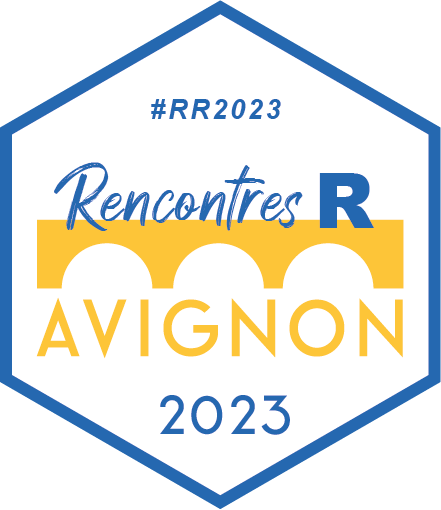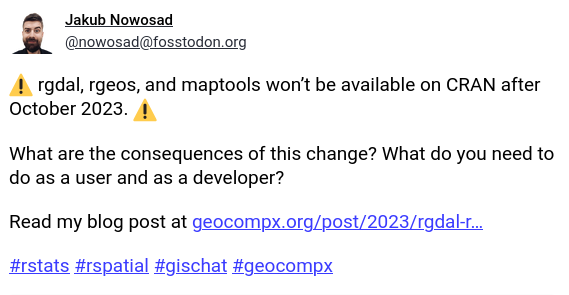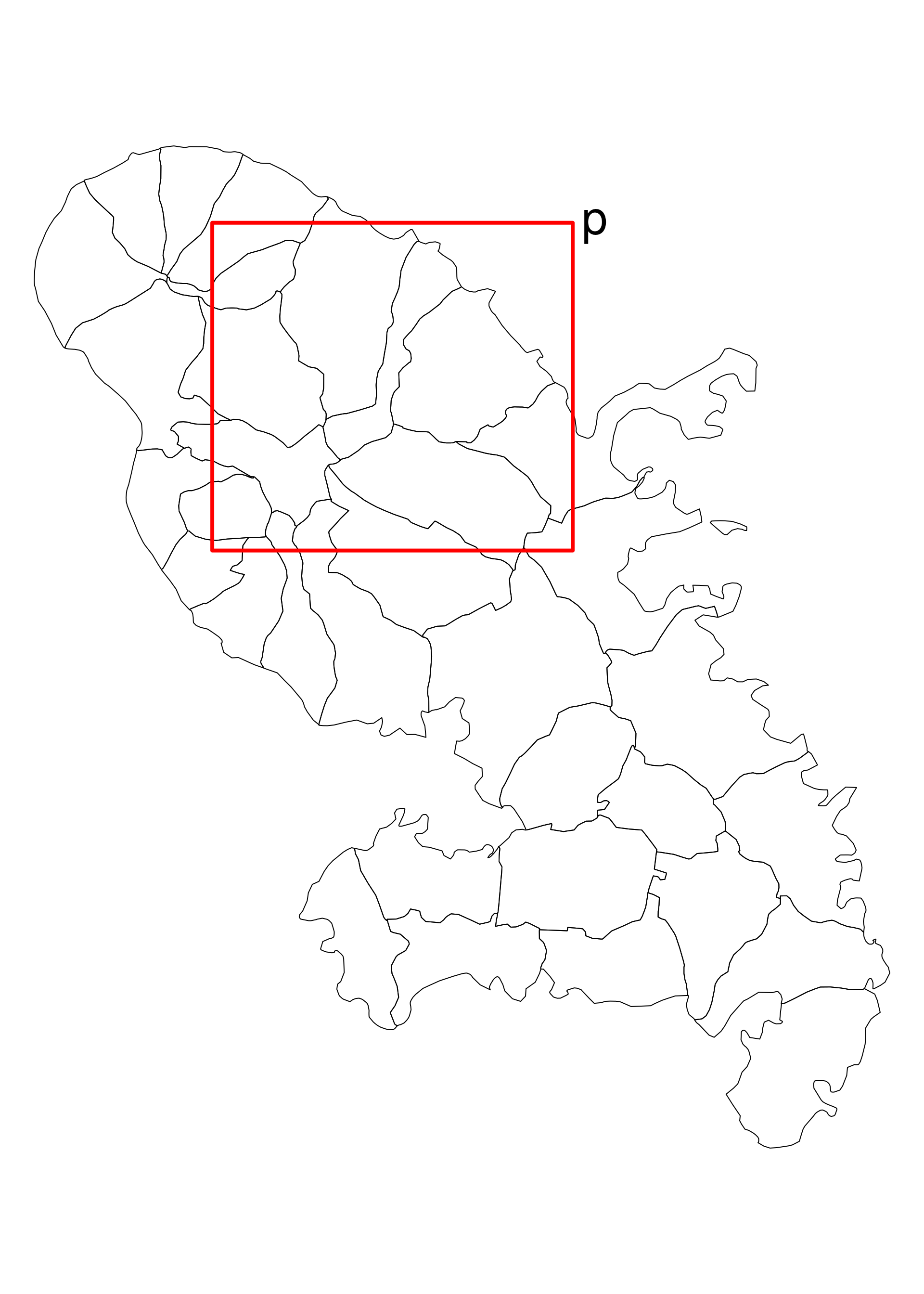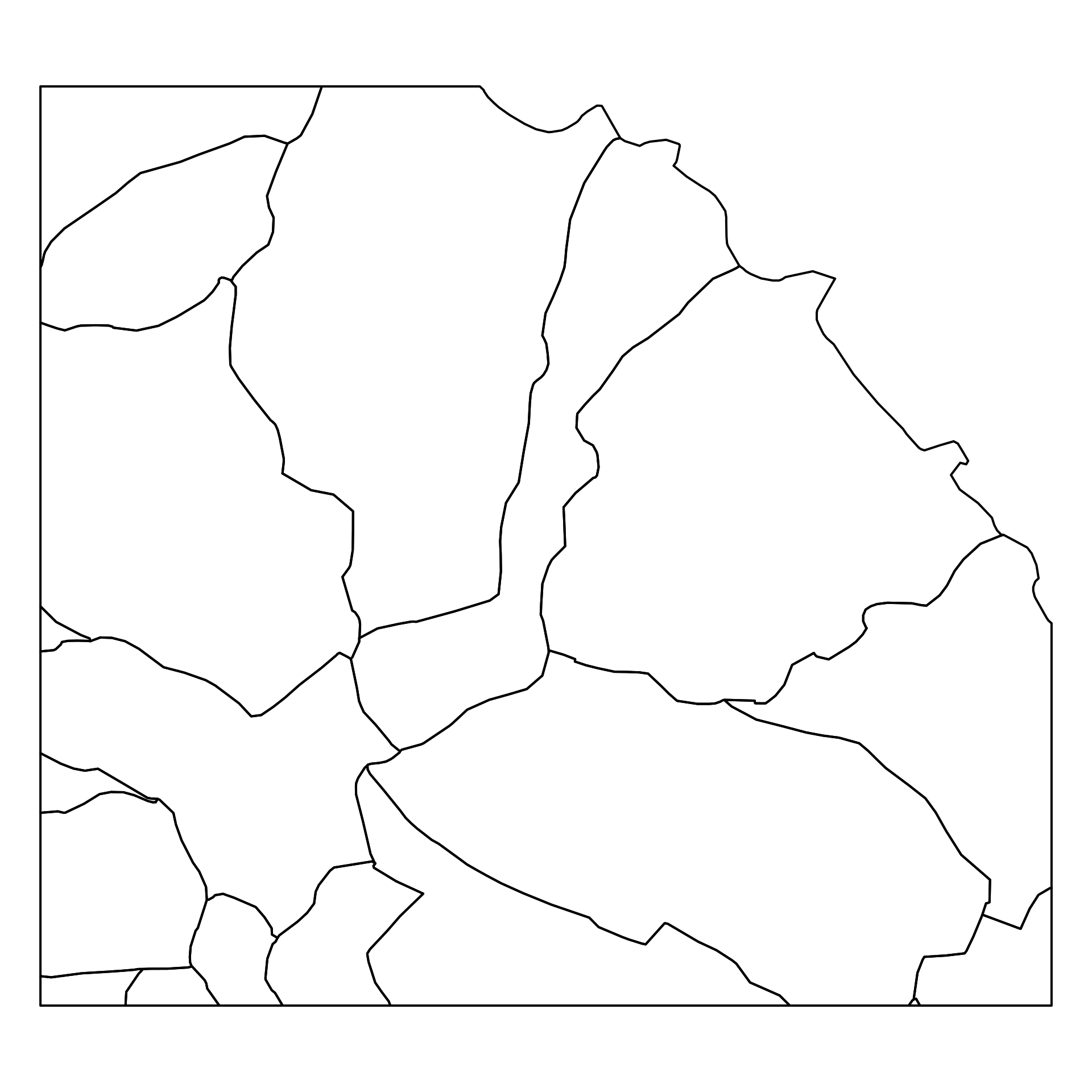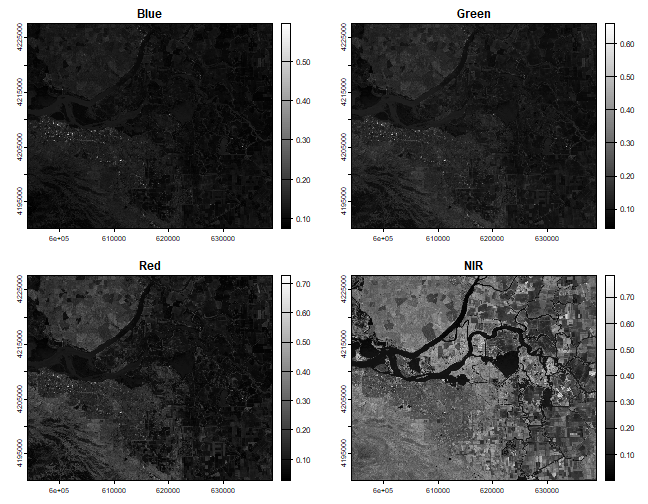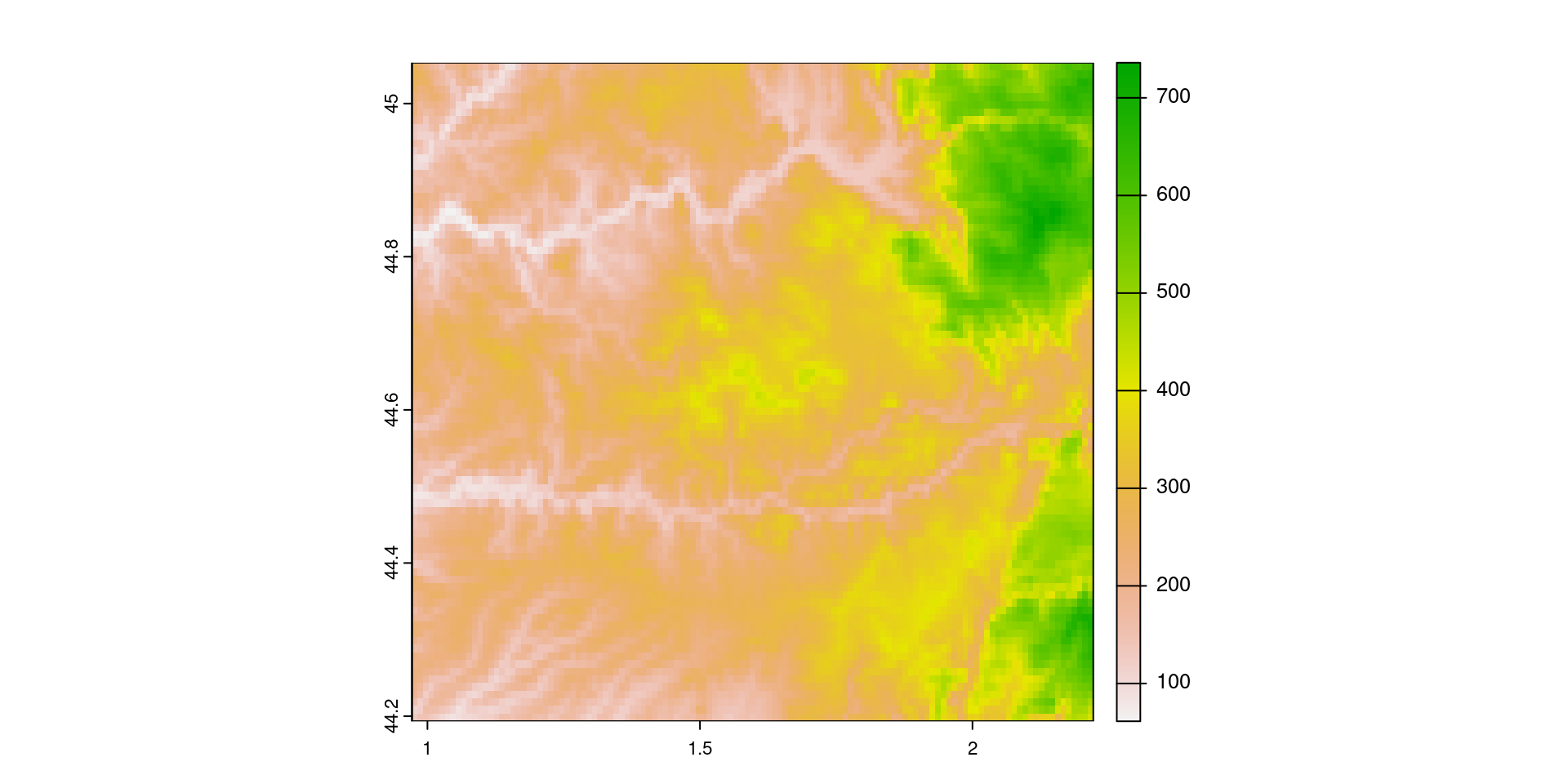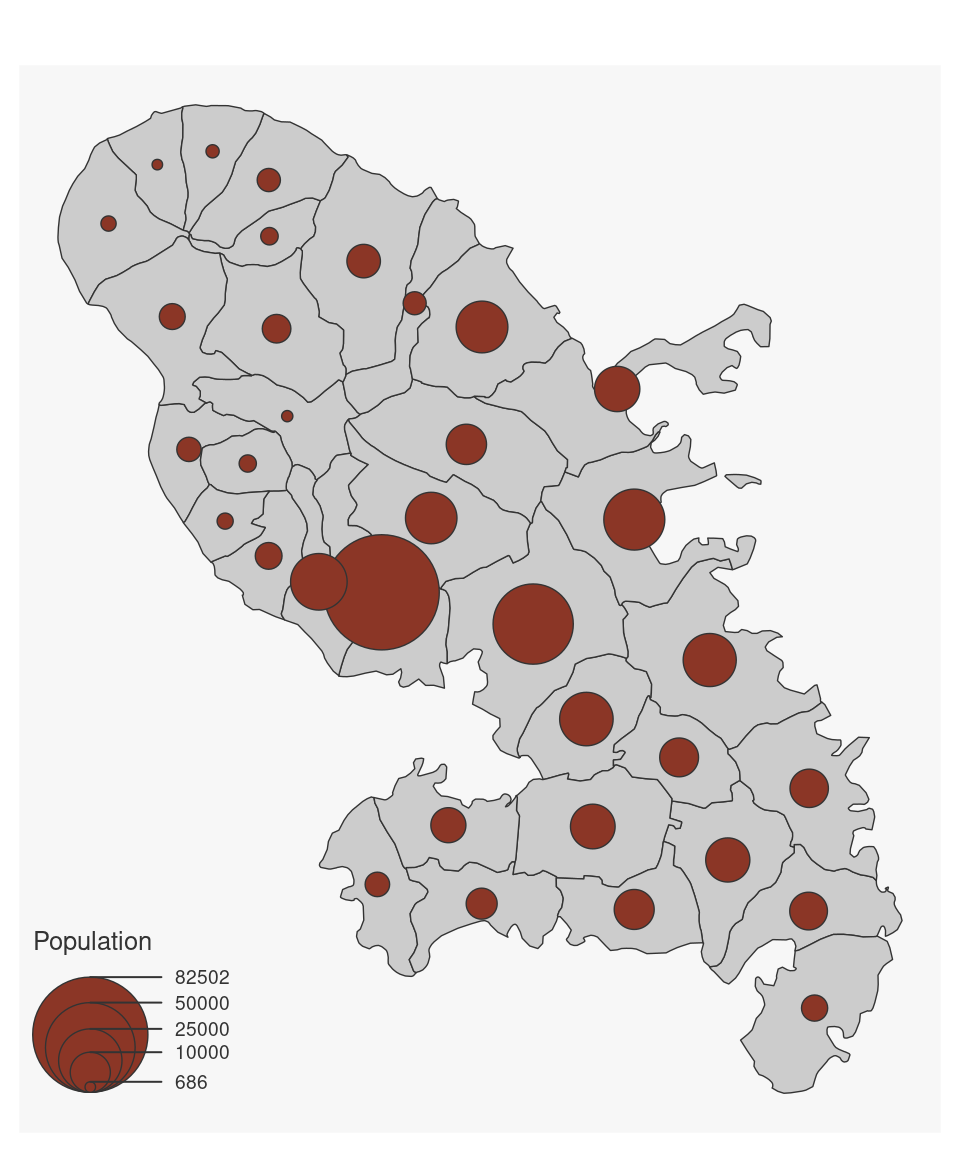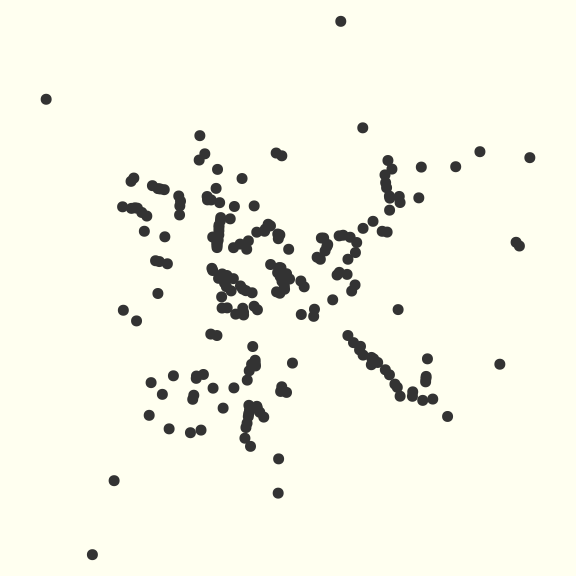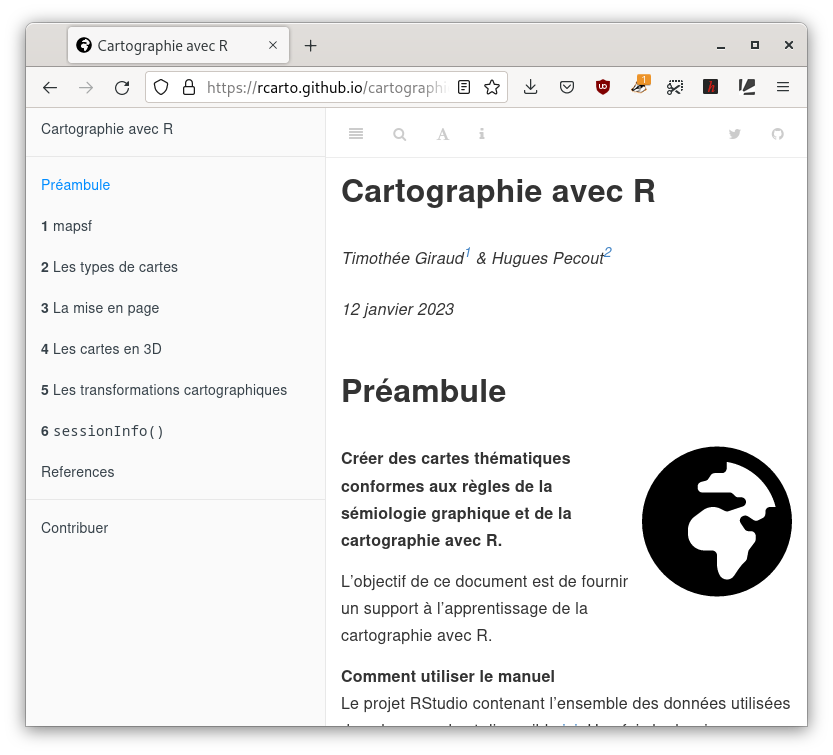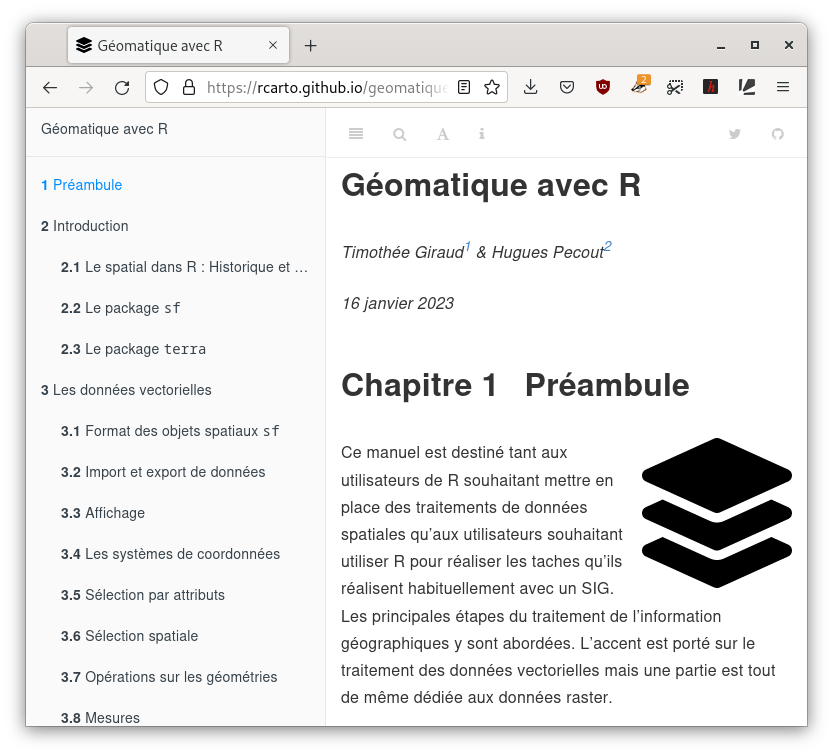| Reverse Dependencies | ||||||
| Type | sf | stars | terra | raster | rgdal | rgeos |
|---|---|---|---|---|---|---|
| Depends | 35 | 3 | 14 | 64 | 9 | 8 |
| Imports | 414 | 27 | 120 | 280 | 109 | 69 |
| Suggests | 177 | 30 | 60 | 97 | 85 | 50 |
| Source : CRAN, 22 juin 2023 | ||||||
L’écosystème spatial de R
Rencontres R - Avignon
RIATE - CNRS
23 juin 2023
Quelques repères historiques
- avant 2003 :
spatial,sgeostat,splancs,akima,geoR,spatstat,spdep,maptools.
- 2003 :
rgdal(Bivand et al., 2023), interface entre R et GDAL/PROJ4
- 2005 :
sp(Pebesma, 2018), classes et méthodes dédiées aux objets spatiaux, adoption rapide - 2008 : support de
spparggplot2 - 2010 :
rgeos(Bivand et Rundel, 2023), interface entre R et GEOS.
- 2010 :
raster(Hijmans, 2023a), support des données raster - 2016 :
sf(Pebesma, 2018), remplacesp,rgdaletrgeos - 2018 :
stars(Pebesma et Bivand, 2023), remplaceraster - 2020 :
terra(Hijmans, 2023b), remplace aussiraster
Rappel (?) sur les données spatiales
Raster
C’est une image localisée dans l’espace.
L’information géographique est alors stockée dans des pixels.
Chaque pixel, défini par une résolution, possède des valeurs qui peuvent être traitées et cartographiées.

Rappel (?) sur les données spatiales
Vecteur
Il s’agit d’objets géométriques de type points, lignes ou polygones.
Ces objets vectoriels ne pixellisent pas.
Chaque objet est défini par un identifiant unique.
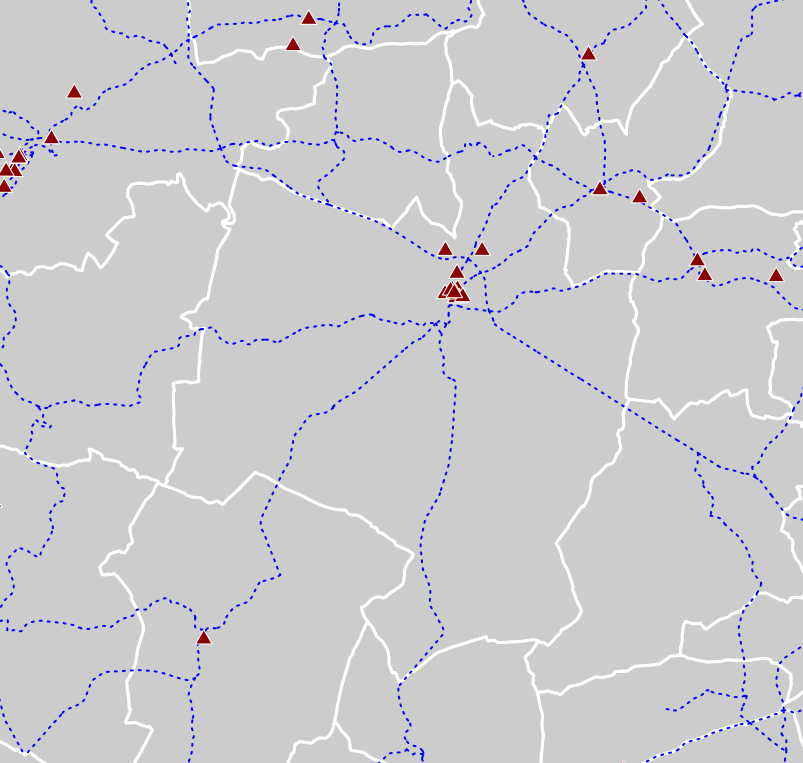
Vecteur et raster

Le socle de l’écosystème
Des bibliothèques géographiques largement utilisées :
- GDAL - Geospatial Data Abstraction Library (GDAL/OGR contributors, 2022)
- PROJ - Coordinate Transformation Software (PROJ contributors, 2021)
- GEOS - Geometry Engine - Open Source (GEOS contributors, 2021)
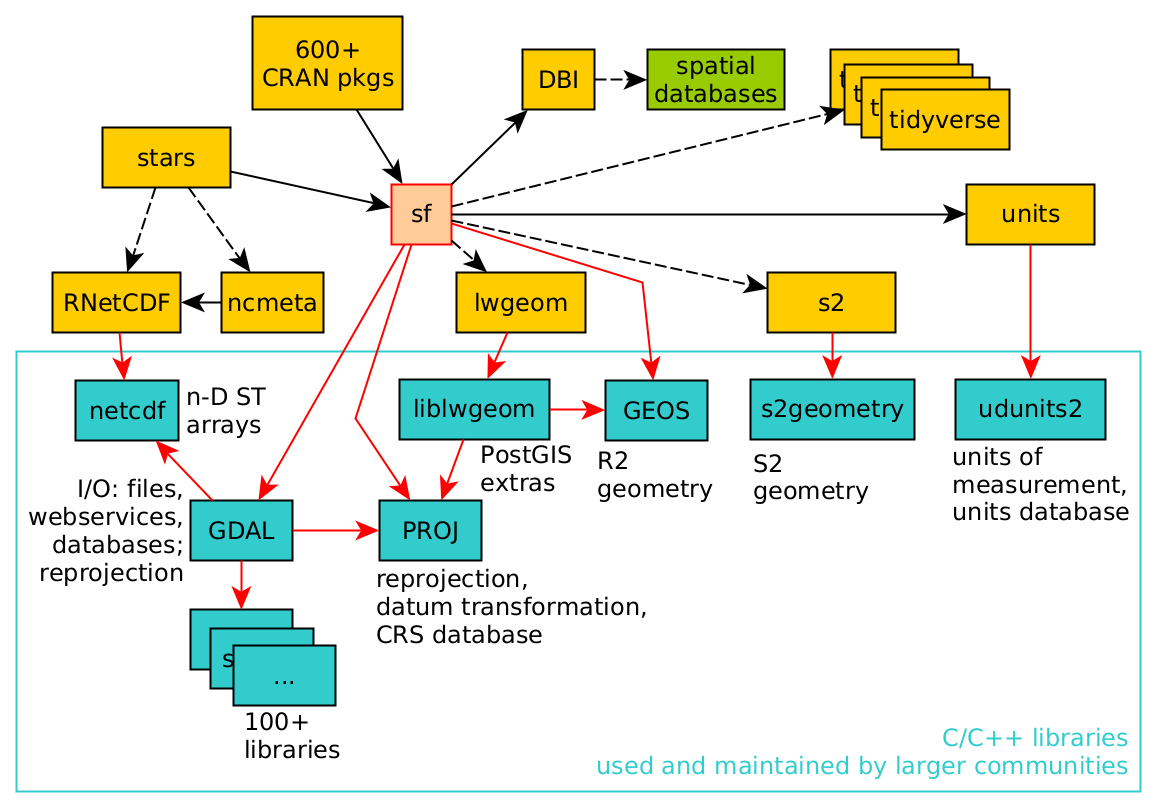
Il s’agit de dépendances externes
- Installation
- Reproductibilité
Envisager la conteneurisation (Nüst et Pebesma, 2021).
rgdal, rgeos, maptools
rgdal, rgeos, maptools
Pour accompagner le processus d’archivage des packages :
- Une série de posts de blog (avril 2022, décembre 2022, avril 2023, mai 2023)
- Plusieurs talks dans des conférences
- Communications directes aux auteurs de packages dépendants (emails, issues)
- Message au démarrage des packages :
Loading required package: spThe legacy packages maptools, rgdal, and rgeos, underpinning the sp package,
which was just loaded, will retire in October 2023.
Please refer to R-spatial evolution reports for details, especially
https://r-spatial.org/r/2023/05/15/evolution4.html.
It may be desirable to make the sf package available;
package maintainers should consider adding sf to Suggests:.
The sp package is now running under evolution status 2
(status 2 uses the sf package in place of rgdal)Warning in load_stuff(): rgeos: versions of GEOS runtime 3.11.1-CAPI-1.17.1
and GEOS at installation 3.9.0-CAPI-1.16.2differrgeos version: 0.6-3, (SVN revision 696)
GEOS runtime version: 3.11.1-CAPI-1.17.1
Please note that rgeos will be retired during October 2023,
plan transition to sf or terra functions using GEOS at your earliest convenience.
See https://r-spatial.org/r/2023/05/15/evolution4.html for details.
GEOS using OverlayNG
Linking to sp version: 1.6-0
Polygon checking: TRUE Le package sf

Publié fin 2016 par Edzer Pebesma.

Principales fonctionnalités
- import / export
- affichage
- géotraitements
- support des données non projetées (sur le globe)
- utilisation du standard simple feature
- compatibilité avec le pipe
(|>ou%>%) - compatibilité avec les opérateurs du
tidyverse.
Format
Les objets sf sont des data.frame dont l’une des colonnes contient des géométries.
Format très pratique, les données et les géométries sont intrinsèquement liées dans un même objet.
Import
Linking to GEOS 3.11.1, GDAL 3.6.2, PROJ 9.1.1; sf_use_s2() is TRUEReading layer `mtq' from data source
`/home/tim/Documents/prz/RencontresR_2023/data/mtq.gpkg' using driver `GPKG'
Simple feature collection with 34 features and 7 fields
Geometry type: MULTIPOLYGON
Dimension: XY
Bounding box: xmin: 690574 ymin: 1592536 xmax: 735940.2 ymax: 1645660
Projected CRS: WGS 84 / UTM zone 20N
Les principaux formats de fichier sont pris en charge
Affichage
Centroides
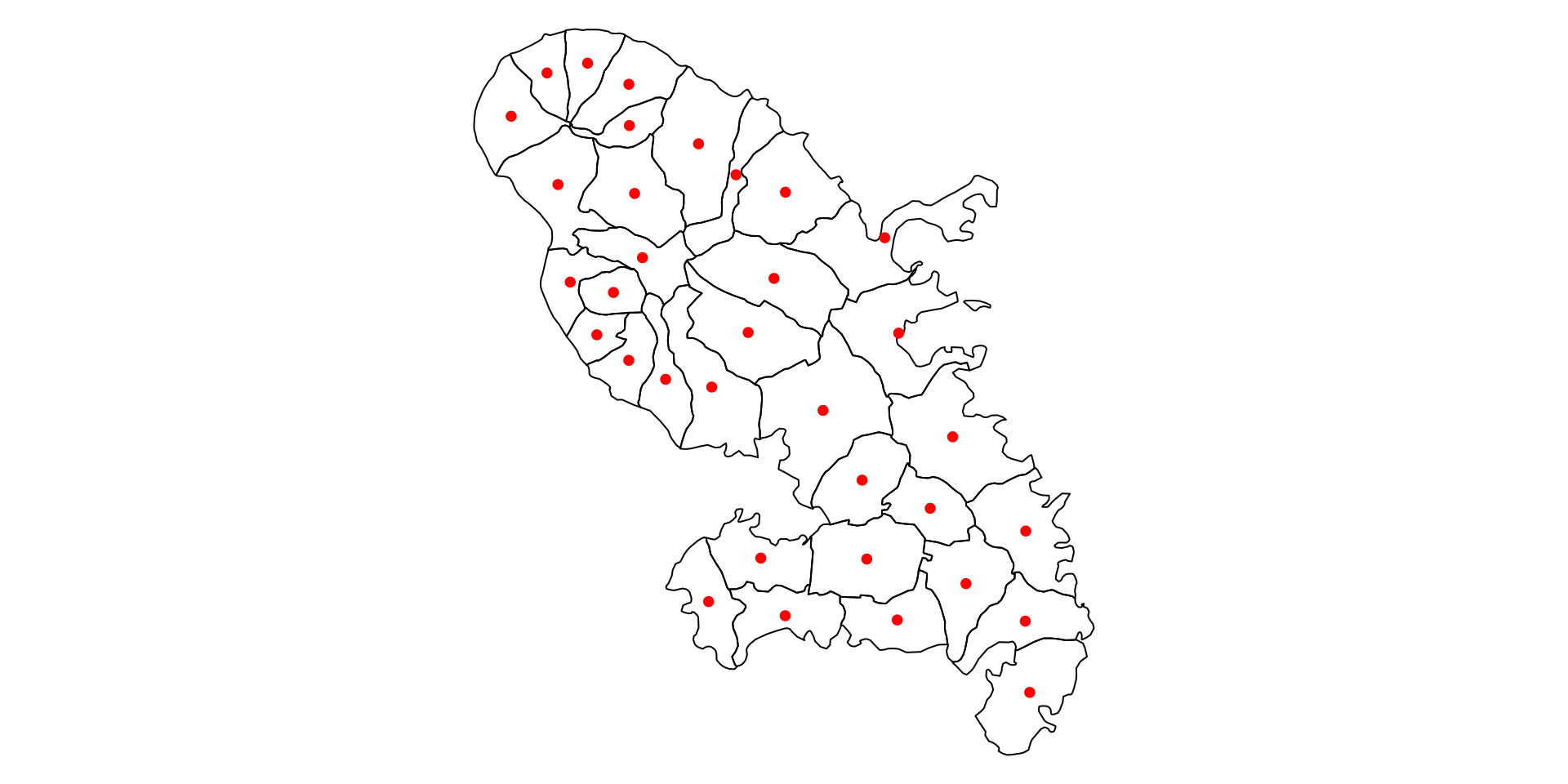
Matrice de distance
Units: [m]
[,1] [,2] [,3] [,4] [,5]
[1,] 0.000 35316.29 3019.561 12247.132 17181.321
[2,] 35316.293 0.00 38303.361 25478.399 18597.357
[3,] 3019.561 38303.36 0.000 15099.121 20200.611
[4,] 12247.132 25478.40 15099.121 0.000 7149.189
[5,] 17181.321 18597.36 20200.611 7149.189 0.000Agrégation
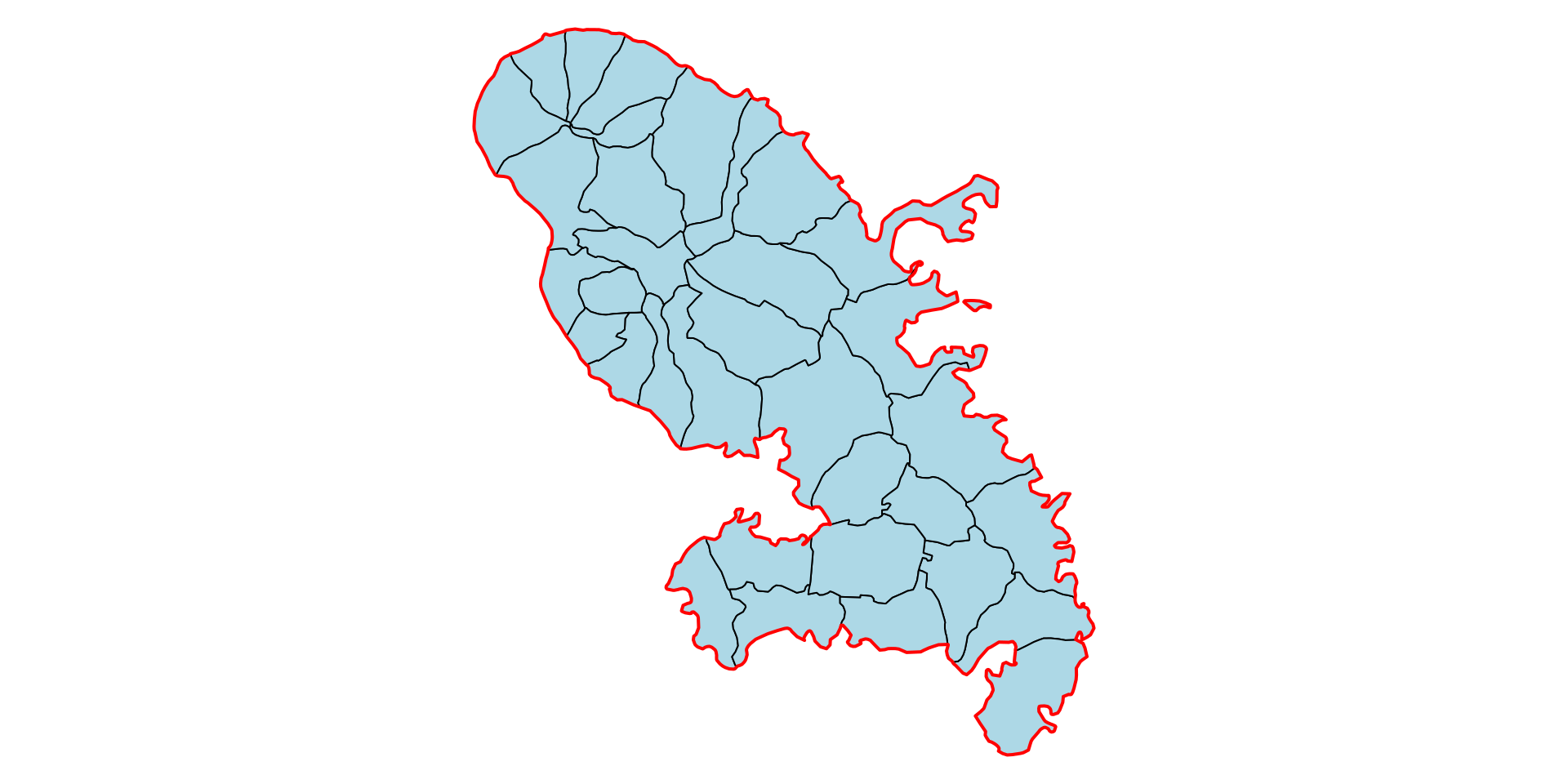
Zone tampon
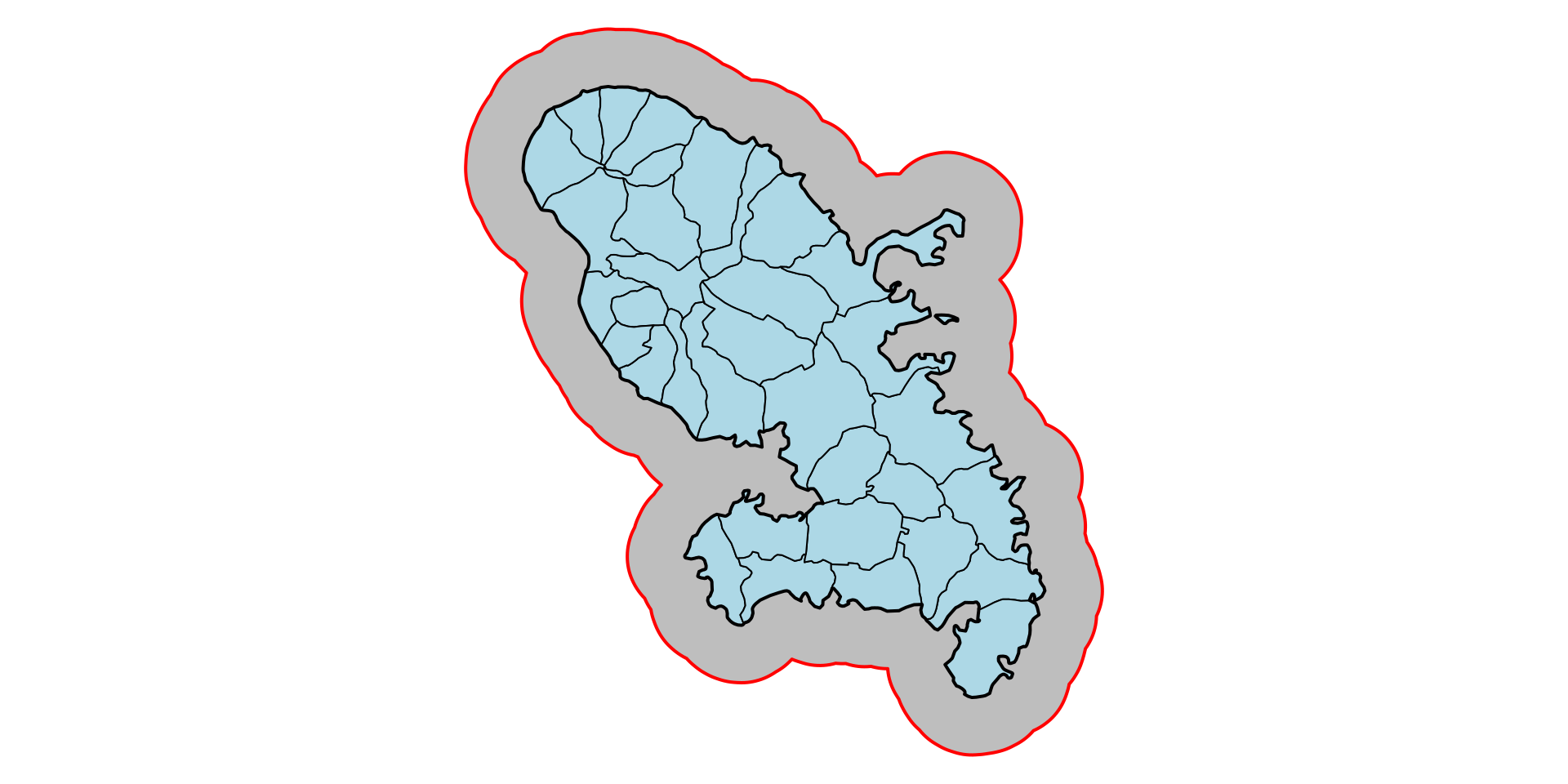
Intersection
Polygones de Voronoi

Le package terra
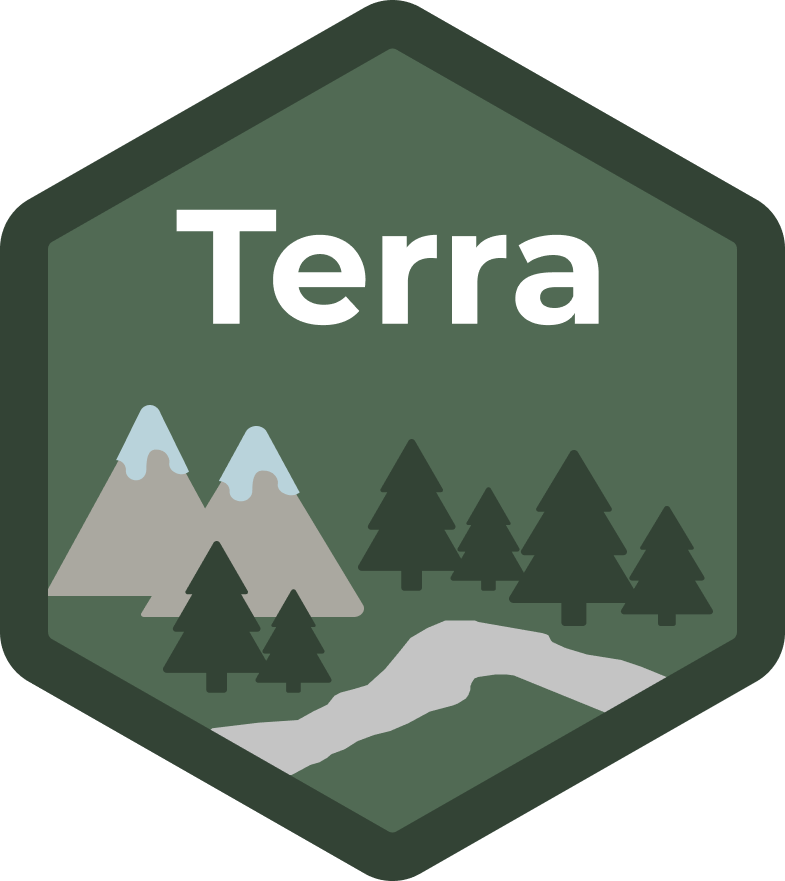
Le package terra permet de gérer des données vectorielles et surtout raster.
Il succède au package raster (Hijmans, 2023a) du même auteur.
Principales fonctionnalités
- Affichage
- Modifications de la zone d’étude (projection, crop, mask, agrégation, fusion…)
- Algèbre spatial (opérations locales, focales, globales, zonales)
- Transformation et conversion (rasterisation, vectorisation)
Import des données
Reprojection

Crop

Mask
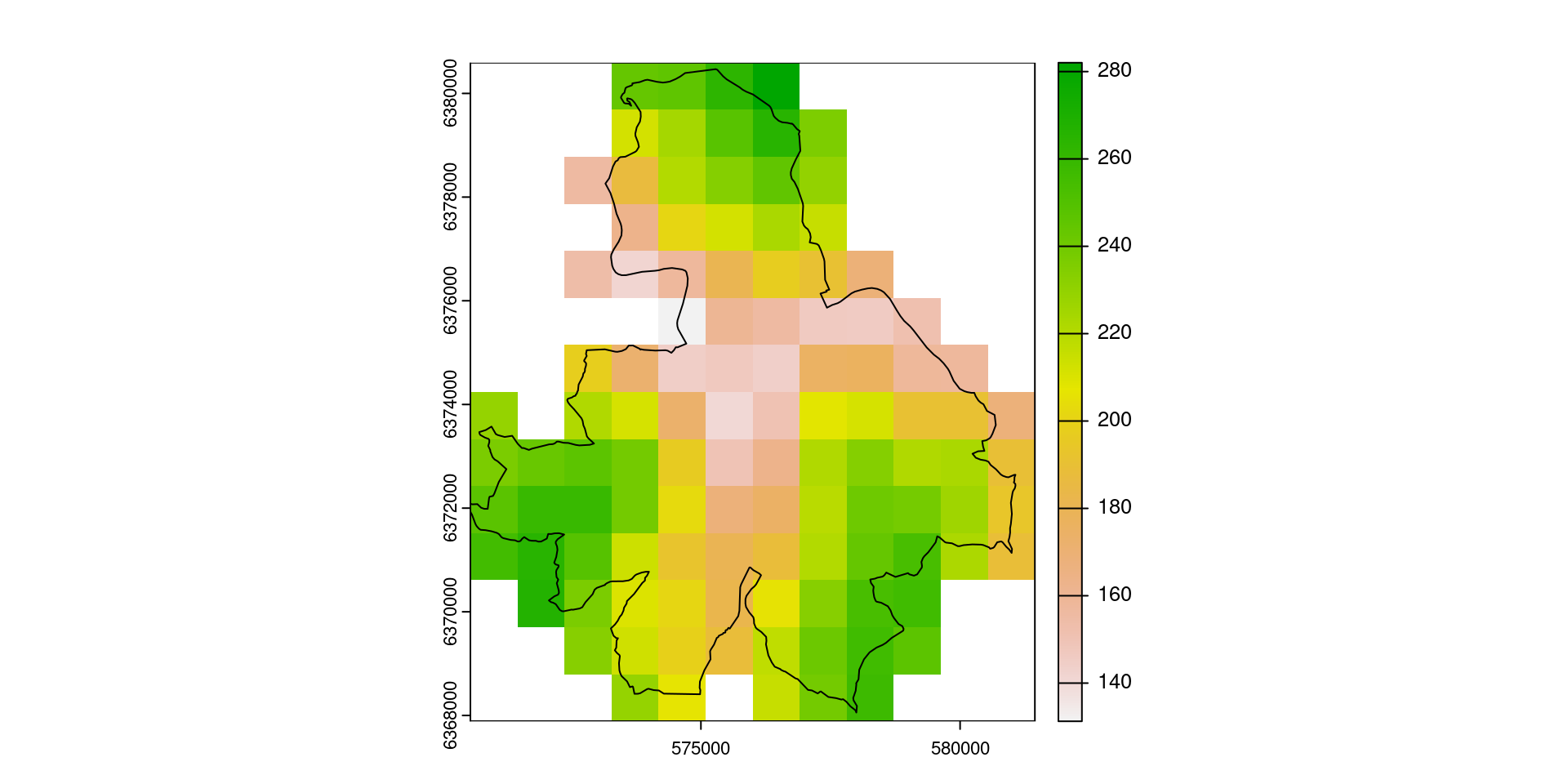
Extract
Cartographie thématique
D’autres packages : mapmisc, choropletr, oceanis…
Le package mapsf

mapsf offre la plupart des types de carte utilisés habituellement.
Successeur de cartography (Giraud et Lambert, 2017).
Fonctionnalités principales
- 9 types de cartes
- Habillage (échelle, flèche nord…)
- Export (png et svg)
- Thèmes
- Insets
- Labels
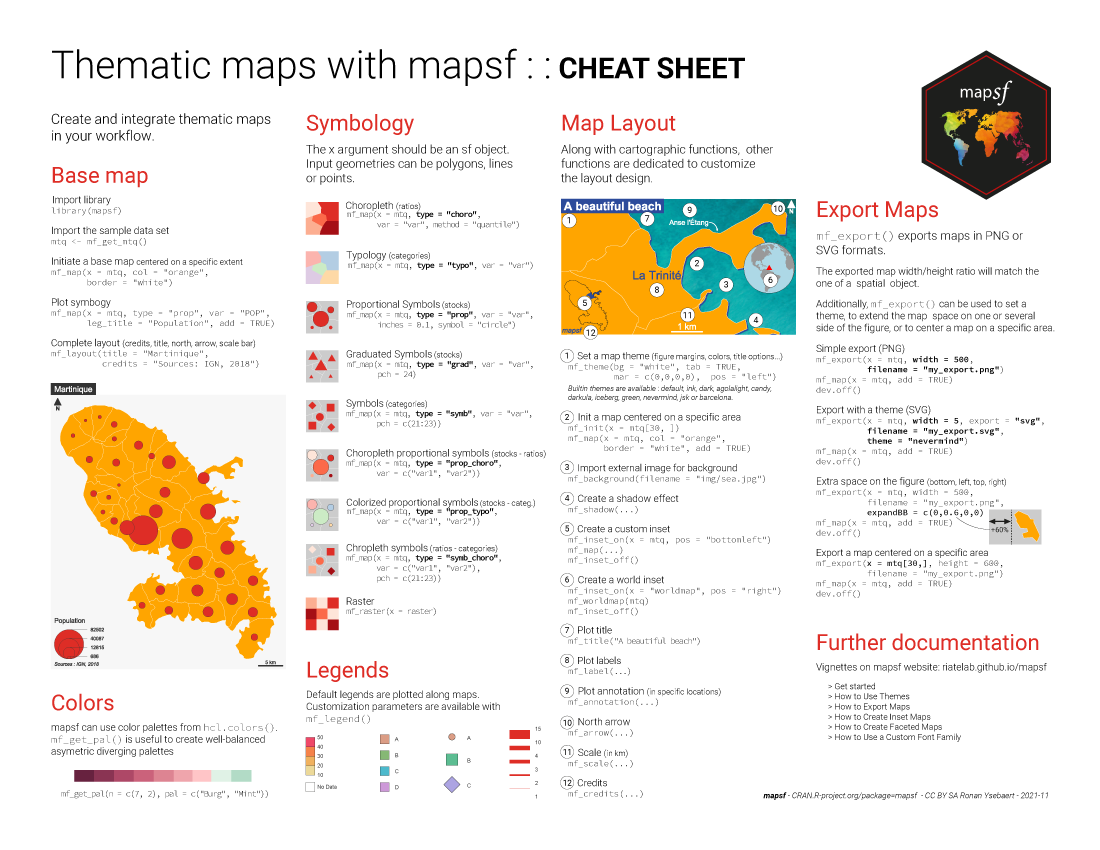
Utilisation simple
Utilisation simple
Utilisation simple
library(mapsf)
# Import the sample dataset
mtq <- mf_get_mtq()
# Plot the base map
mf_map(x = mtq)
# Plot proportional symbols
mf_map(
x = mtq,
var = "POP",
type = "prop",
leg_title = "Population"
)
# Plot a map layout
mf_layout(
title = "Population in Martinique",
credits =
paste0("T. Giraud;",
"Sources: INSEE & IGN, 2018"
)
)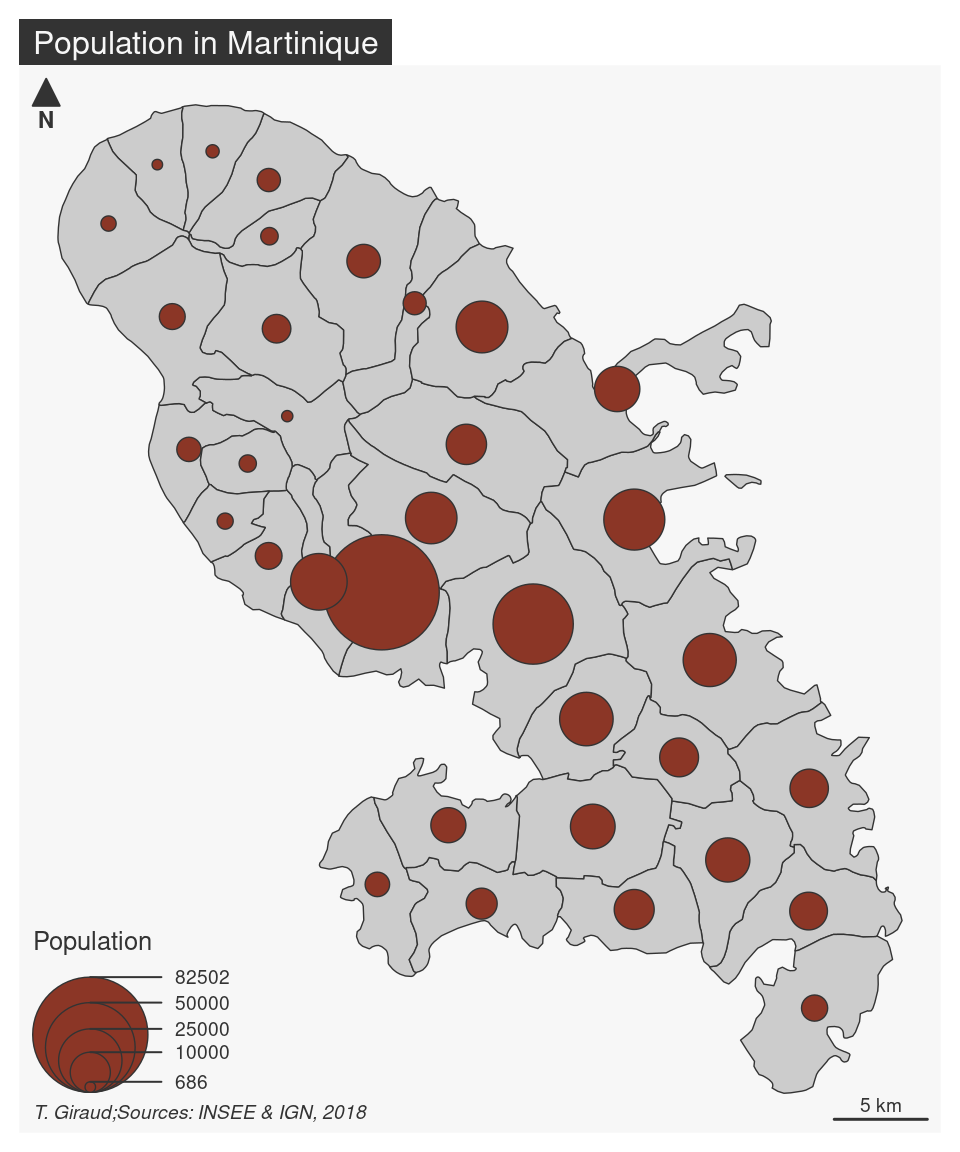
Utilisation avancée
# Export a map with a theme and extra margins
mf_theme("agolalight", bg = "ivory1")
mf_export(
x = mtq, filename = "img/mtq.png",
width = 600, res = 120,
expandBB = c(0, 0, 0, .3)
)
# Plot a shadow
mf_shadow(mtq, col = "grey90", add = TRUE)
# Plot a choropleth map
mf_map(
x = mtq, var = "MED", type = "choro",
pal = "Dark Mint",
breaks = "quantile",
nbreaks = 6,
leg_title = "Median Income\n(euros)",
leg_val_rnd = -2,
add = TRUE
)
# Start an inset map
mf_inset_on(x = "worldmap", pos = "right")
# Plot mtq position on a worldmap
mf_worldmap(mtq, col = "#0E3F5C")
# Close the inset
mf_inset_off()
# Plot a title
mf_title("Wealth in Martinique, 2015")
# Plot credits
mf_credits("T. Giraud\nSources: INSEE & IGN, 2018")
# Plot a scale bar
mf_scale(size = 5)
# Plot a north arrow
mf_arrow("topleft")
dev.off()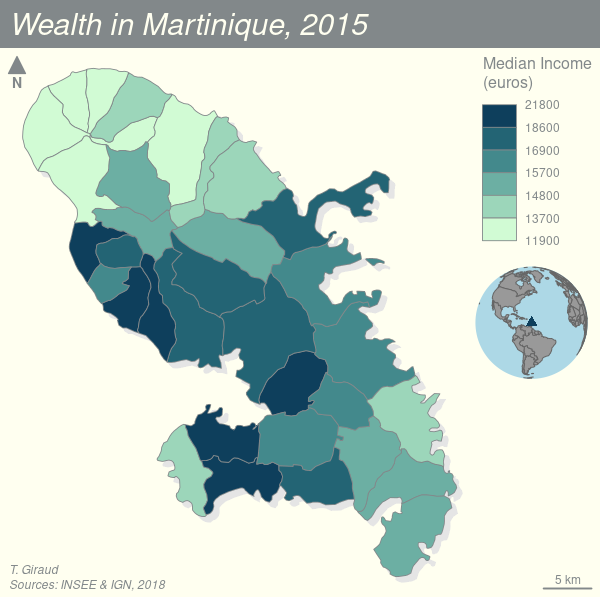
Cartographie interactive

leaflet (Cheng et al., 2023), repose sur la bibliothèque JS leaflet
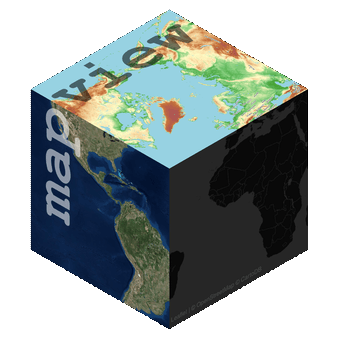
mapview (Appelhans et al., 2022), repose sur le package leaflet

mapdeck (Cooley, 2020), repose sur les bibliothèques JS Mapbox GL et Deck.gl
tmap dispose d’un mode interactif (qui s’appuie sur le package leaflet aussi).
Cartographie interactive
Cartographie interactive avec shiny
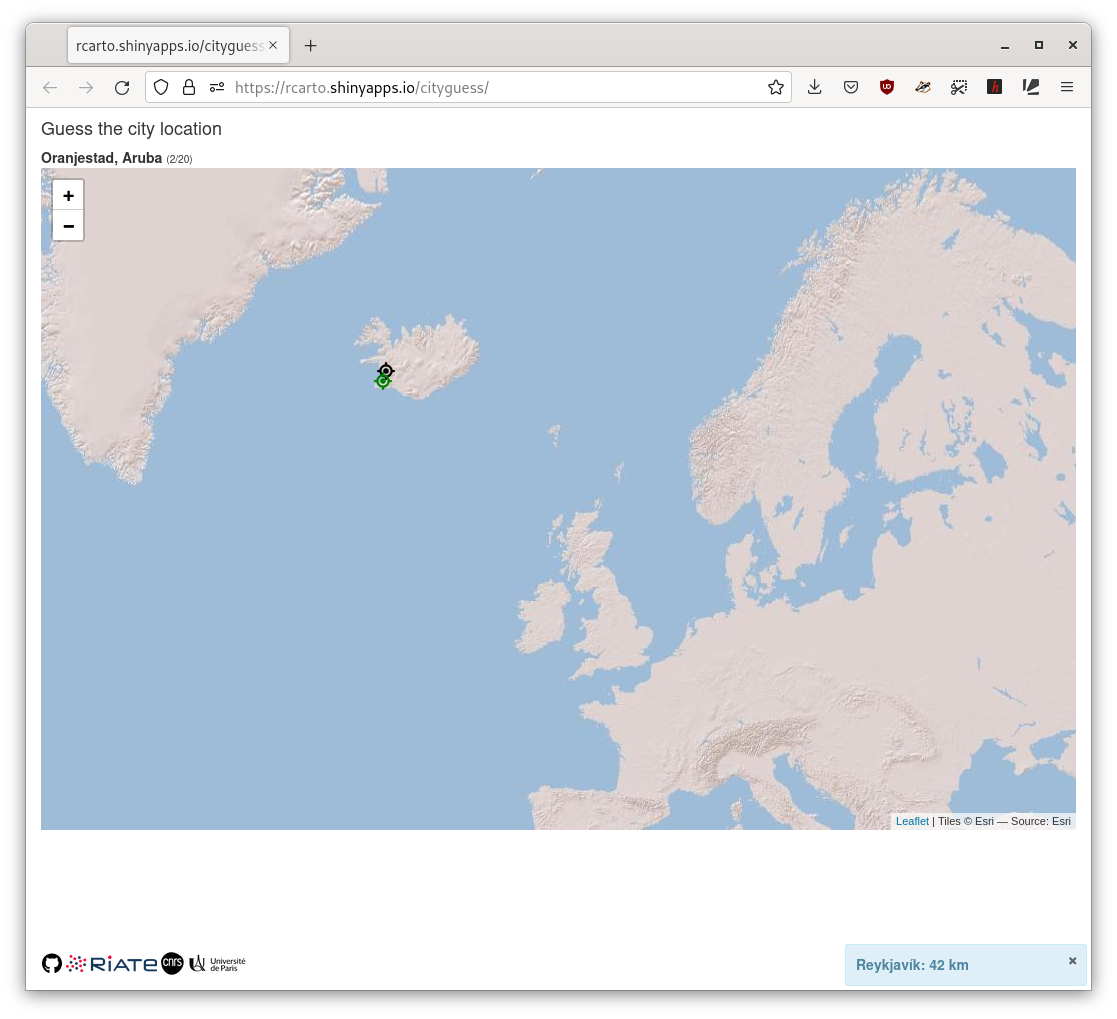
Fond de carte
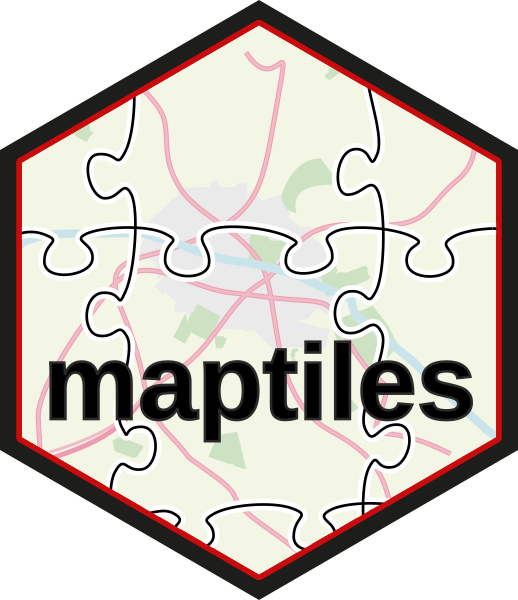 Le package
Le package maptiles (Giraud, 2023b) permet de télécharger des fonds de carte (raster).

Alternatives
ceramicggmap(pourggplot2)ggspatial(pourggplot2, utiliserosm)mapboxapi(mapbox)mapsapi(google, utiliseRgoogleMaps)OpenStreetMap(nécessite Java)RgoogleMaps(google)rosm- …
Palettes de couleurs
De nombreuses palettes sont directement disponibles dans R-base et près de 70 (!) packages proposent des palettes.
hcl.colors()paletteer(Hvitfeldt, 2021) propose 2587 palettes (!!!)cols4all(Tennekes, 2023) propose une app shiny
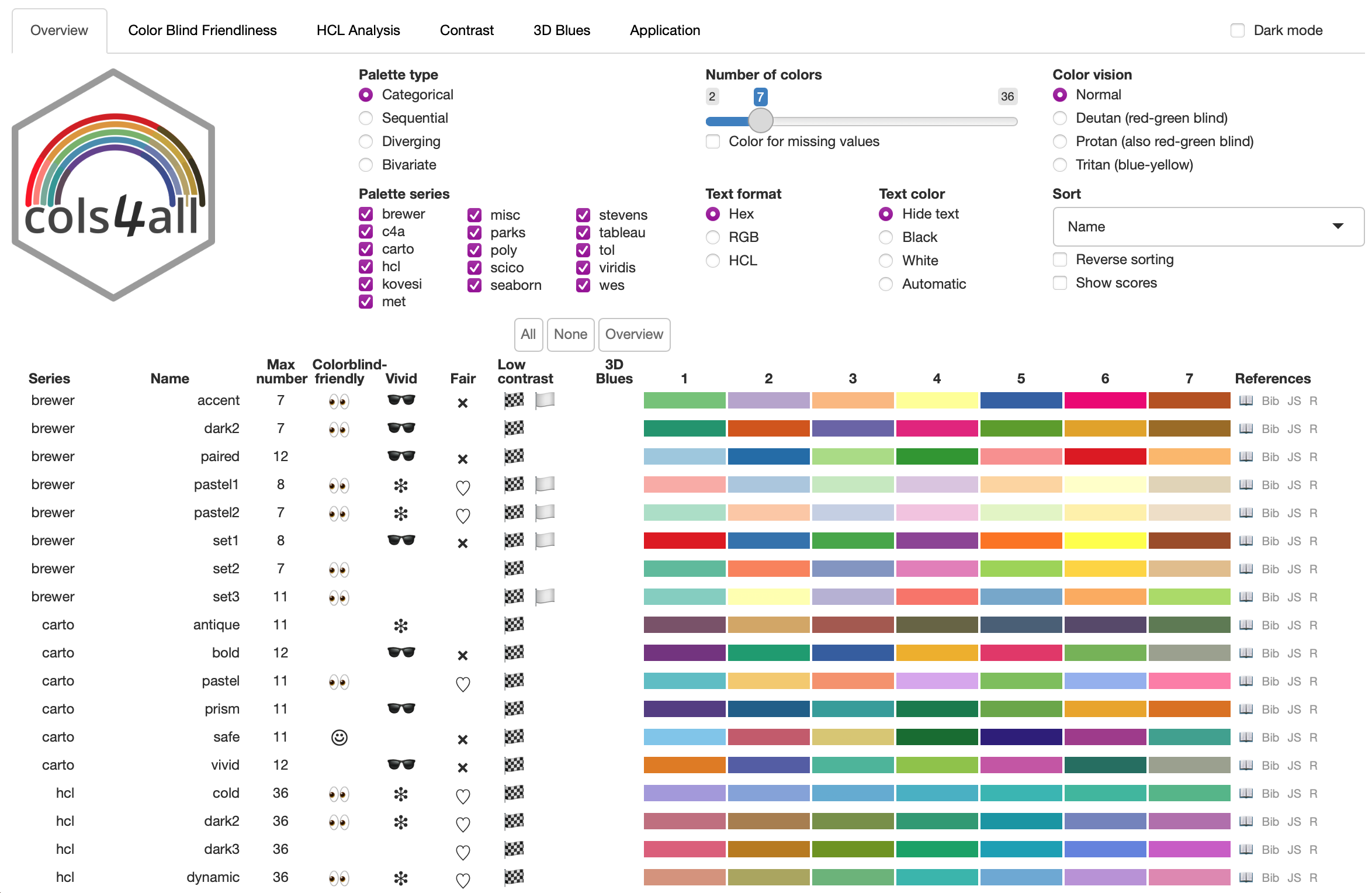
cols4all::c4a_gui()Analyse spatiale / statistique spatiale
spatstat: Analyse statistique de semis de pointsgstat: Variogram et Krigeagergeoda: Geoda avec RGWmodel,spgwr: Geographically Weighted Models
CRAN Task View: Analysis of Spatial Data
- Spatial sampling
- Point pattern analysis
- Geostatistics
- Disease mapping and areal data analysis
- Spatial regression
- Ecological analysis
Session Geospatial à 11h!

La session Workflow a l’air cool aussi !
Télécharger des données spatiales
Maillages administratifs :
rnaturalearth pour les pays du monde
giscoR pour les régions européennes
tigris, mapSpain, geobr…
Données climatiques :
geodata (+ plein d’autres choses)
Altitudes :
elevatr
Occurences d’especes :
spocc
Données eco / socio / démographique :
wbstats (World Bank)
eurostat
rdhs (santé)
…
Données satellitaires :
sen2r (Sentinel-2)
MODIStsp (MODIS)
rgee (Google Earth Engine)
nasapower (météo, climato)
Accessibilité des restaurants et des hotels dans le centre d’Avignon
Acquisition des données
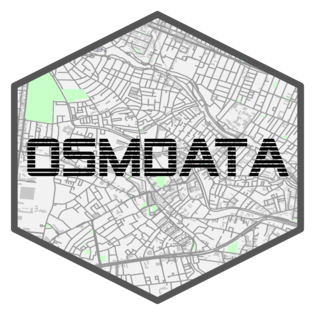
Le package osmdata (Padgham et al., 2017) utilise l’API du service Overpass turbo pour extraire des données de la BD OpenStreetMap.
Nous utilisons le système de clef/valeur d’OSM pour construire la requête.
OpenStreetMap
 Une base de données cartographique libre et contributive.
Une base de données cartographique libre et contributive.
Conditions d’utilisation
OpenStreetMap est en données libres : vous êtes libre de l’utiliser dans n’importe quel but tant que vous créditez OpenStreetMap et ses contributeurs. Si vous modifiez ou vous appuyez sur les données d’une façon quelconque, vous pouvez distribuer le résultat seulement sous la même licence. (…)
Contributions
(…) Nos contributeurs incluent des cartographes enthousiastes, des professionnels du SIG, des ingénieurs qui font fonctionner les serveurs d’OSM, des humanitaires cartographiant les zones dévastées par une catastrophe et beaucoup d’autres. (…)
Couverture/complétude
- Données France : 4,1 GB
- Données Chine : 0,99 GB
- Données Afrique : 5,8 GB
Densité des restaurants
Pour modéliser les variations de densités de restaurants dans le centre ville d’Avignon nous pouvons utiliser la méthode de lissage par noyaux (KDE) grâce au package spatstat (Baddeley et al., 2015).
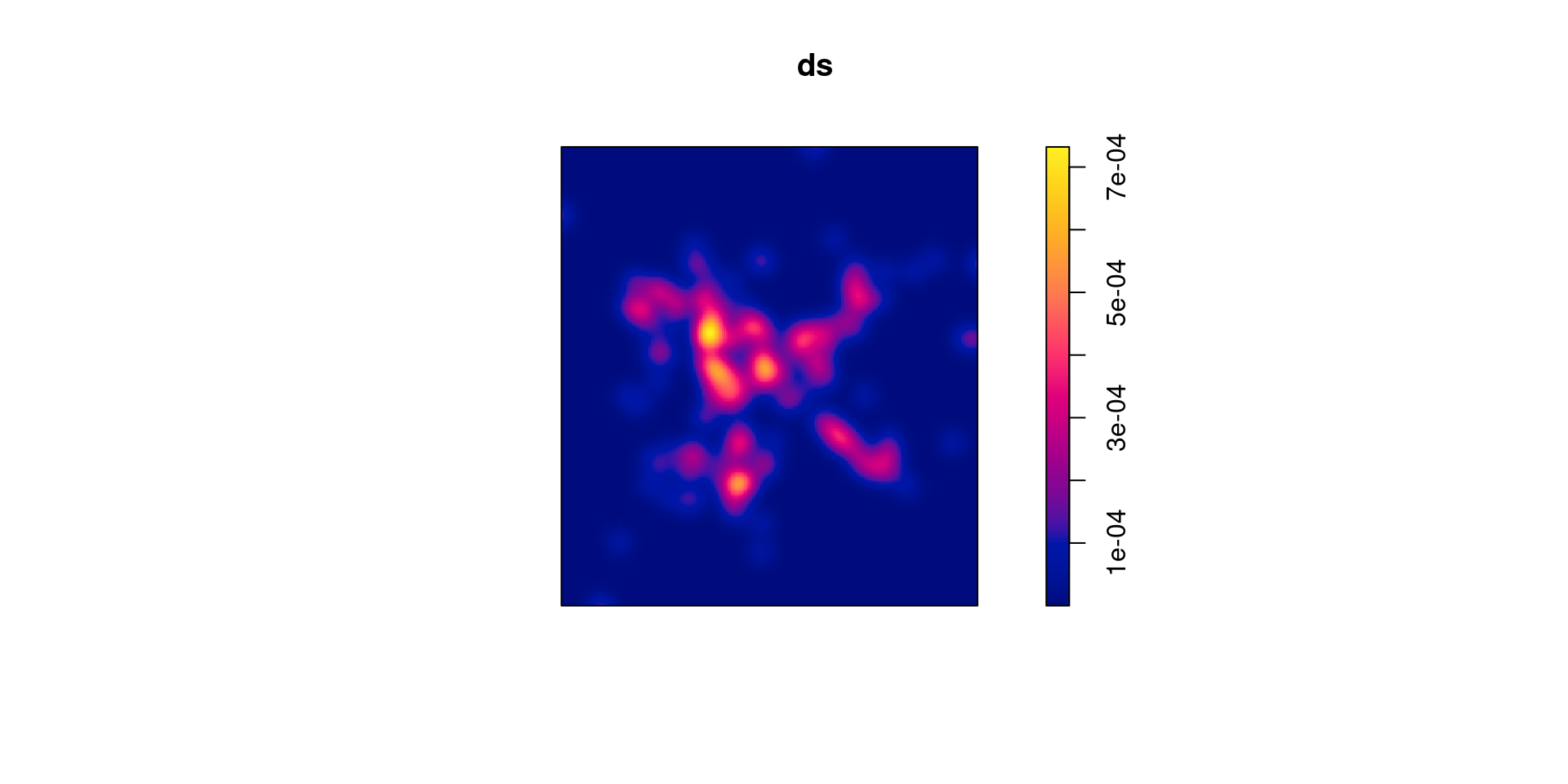
Densité des restaurants
On peut améliorer la représentation des résultats en les superposant à un fond de carte raster.
Téléchargement des tuiles et superposition
library(maptiles)
library(mapsf)
tiles_osm <- get_tiles(r,
provider = "CartoDB.Positron",
zoom = 15,
crop = TRUE,
cachedir = "cache")
mf_theme(mar = c(0,0,0,0), inner = TRUE)
mf_export(tiles_osm, filename = "img/avignon_dens1.png",
width = ncol(tiles_osm), height = nrow(tiles_osm))
mf_raster(tiles_osm, add = TRUE)
mf_raster(r, alpha = 0.6, add = TRUE)
mf_map(resto, add = TRUE)
dev.off()
Densité des restaurants
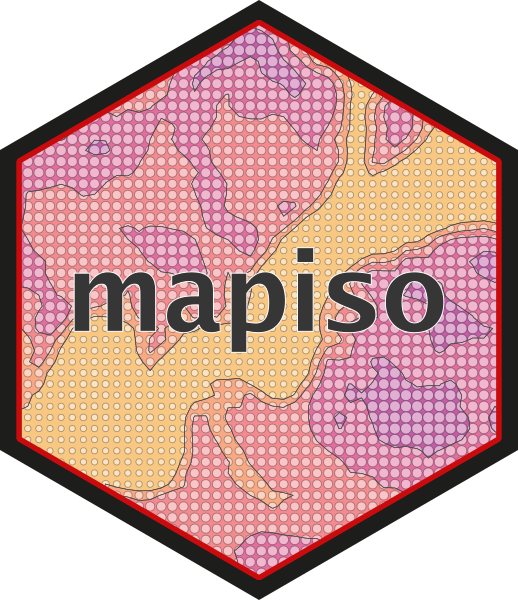
Nous pouvons aussi transformer le raster des densités en polygones de plages de densités grâce au package mapiso (Giraud, 2023a).
Transformation du raster en polygones
library(mapiso)
# Limites des classes
maxval <- max(values(r))
bks <- c(seq(0, floor(maxval), 1), maxval)
# Transformation du raster en polygones
iso_dens <- mapiso(r, breaks = bks)
# Suppression de la première classe ([0, 1[)
iso_dens <- iso_dens[-1, ]
# Affichage
mf_export(r, "img/iso_dens.png", width = ncol(r)*2)
mf_raster(r, add = TRUE)
mf_map(iso_dens, col = NA, add = TRUE)
dev.off()
Densité des restaurants
La dernière étape consiste à superposer ces polygones au fond de carte.
Cartographie
mf_export(tiles_osm, filename = "img/avignon_dens2.png",
width = 600,
expandBB = c(0,0,0,.5))
mf_raster(tiles_osm, add = TRUE)
mf_map(iso_dens, var = "isomin", type = "choro",
breaks = bks[-1], border = "white",
pal = "Teal", alpha = .9,
leg_pos = "right",
leg_val_rnd = 1,
leg_title = paste0("Densité de restaurants dans\n",
"un voisinage gaussien (σ = 50m),\n",
"en restaurants par hectare"),
add = TRUE)
mf_map(resto, cex = .5, add = TRUE)
mf_credits("T. Giraud, 2023\nOpenStreetMap contributors, 2023",
pos = "bottomright", bg = "white")
mf_scale(pos = "bottomleft", size = 250, unit = "m")
mf_arrow(pos = "topright")
mf_title("Densité des restaurants dans le centre-ville d'Avignon")
dev.off()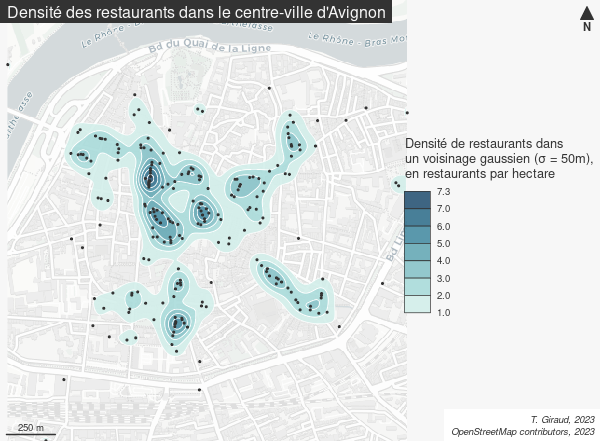
Acquisition de données pour un fond de carte vectoriel
Nous pouvons aussi utiliser un fond de carte vectoriel.
Ici nous allons préparer un fond de carte constitué :
- des espaces verts
- des surfaces en eaux
- des routes et rails
- des bâtiments
- des hotels et des restaurants
Acquisition des données OSM
library(sf)
library(osmdata)
center <- data.frame(x=3903683, y=2329735) |>
st_as_sf(coords = c("x","y"), crs = "EPSG:3035") |>
st_buffer(dist = 1000)
bb <- st_transform(center,"EPSG:4326") |>
st_bbox()
water <- opq(bbox = bb)|>
add_osm_feature(key = 'natural', value = "water") |>
osmdata_sf() |>
unique_osmdata()
river <- c(st_geometry(water$osm_polygons),
st_geometry(water$osm_multipolygons)) |>
st_cast('MULTIPOLYGON') |>
st_make_valid() |>
st_transform(st_crs(center))|>
st_intersection(center) |>
st_union()
green <- opq(bbox = bb)|>
add_osm_features(features = list(
"leisure" = c("park", "garden"),
"landuse" = c("cemetery", "grass", "forest"))
) |>
osmdata_sf() |>
unique_osmdata()
esp_vert <- st_geometry(green$osm_polygons) |>
st_cast('MULTIPOLYGON') |>
st_make_valid() |>
st_transform(st_crs(center))|>
st_intersection(center) |>
st_union()
highway <- opq(bbox = bb)|>
add_osm_feature(key = 'highway') |>
osmdata_sf() |>
unique_osmdata()
routes <- st_geometry(highway$osm_lines) |>
st_cast('LINESTRING') |>
st_make_valid() |>
st_transform(st_crs(center))|>
st_intersection(center) |>
st_union() |>
st_buffer(5) |>
st_buffer(-3)
railway <- opq(bbox = bb)|>
add_osm_feature(key = 'railway') |>
osmdata_sf() |>
unique_osmdata()
rail <- st_geometry(railway$osm_lines) |>
st_cast('LINESTRING') |>
st_make_valid() |>
st_transform(st_crs(center))|>
st_intersection(center) |>
st_union()
building <- opq(bbox = bb)|>
add_osm_feature(key = 'building') |>
osmdata_sf() |>
unique_osmdata()
batiments <- c(st_geometry(building$osm_polygons),
st_geometry(building$osm_multipolygons)) |>
st_cast('MULTIPOLYGON') |>
st_make_valid() |>
st_transform(st_crs(center))|>
st_intersection(center) |>
st_union()
restaurants <- opq(bbox = bb)|>
add_osm_feature(key = 'amenity', value = "restaurant") |>
osmdata_sf() |>
unique_osmdata()
restaurants_points <- st_geometry(restaurants$osm_points) |>
st_transform(st_crs(center))|>
st_intersection(center)
restaurants_poly <- st_geometry(restaurants$osm_polygons) |>
st_centroid() |>
st_transform(st_crs(center))|>
st_intersection(center)
resto <- c(restaurants_points, restaurants_poly)
tourism <- opq(bbox = bb)|>
add_osm_feature(key = 'tourism', value = "hotel") |>
osmdata_sf() |>
unique_osmdata()
hotel_points <- tourism$osm_points[, "name"] |>
st_set_agr("constant") |>
st_transform(st_crs(center))|>
st_intersection(center)
hotel_poly <- rbind(tourism$osm_polygons[, "name"],
tourism$osm_multipolygons[, "name"]) |>
st_set_agr("constant") |>
st_centroid() |>
st_transform(st_crs(center))|>
st_intersection(center)
hotel <- rbind(hotel_points, hotel_poly)
st_write(obj = hotel, dsn = "data/avignon.gpkg", layer = "hotel")
st_write(obj = resto, dsn = "data/avignon.gpkg", layer = "resto")
st_write(obj = batiments, dsn = "data/avignon.gpkg", layer = "batiments")
st_write(obj = rail, dsn = "data/avignon.gpkg", layer = "rail")
st_write(obj = routes, dsn = "data/avignon.gpkg", layer = "routes")
st_write(obj = esp_vert, dsn = "data/avignon.gpkg", layer = "esp_vert")
st_write(obj = river, dsn = "data/avignon.gpkg", layer = "river")
st_write(obj = center, dsn = "data/avignon.gpkg", layer = "center")Il suffit maintenant de combiner toutes ces couches pour constituer un fond de carte.
Cartographie
library(mapsf)
mf_theme("candy", bg ="#f7f7f7")
mf_export(center, "img/avignon.png", width = 768, res = 110)
mf_map(center, col = "#f2efe9", border = NA, add = TRUE)
mf_map(river, col = "#aad3df", border = "#aad3df", lwd = .5, add = TRUE)
mf_map(esp_vert, col = "#c8facc", border = "#c8facc", lwd = .5, add = TRUE)
mf_map(rail, col = "grey50", lty = 2, lwd = .2, add = TRUE)
mf_map(routes, col = "white", border = "white", add = TRUE)
mf_map(batiments, col = "#d9d0c9", border = "#c6bab1", lwd = 1, add = TRUE)
mf_map(hotel, col = "white", bg = "#000094",
pch = 21, lwd = 1, cex = 1, add = TRUE)
mf_map(resto, col = "white", bg = "#940010",
pch = 23, lwd = 1, cex = 1, add = TRUE)
mf_map(center, col = NA, border = "grey25", lwd = 4, add = TRUE)
mf_title("Avignon")
mf_credits("T. Giraud, 2023\nOpenStreetMap contributors, 2023")
mf_scale(100, unit = "m")
mf_arrow(pos = "topright")
mf_legend(type = "symb", pos = "bottomright2",
val = c("Hotels", "Restaurants"),
pal = c("#000094", "#940010"),
pt_cex = c(1, 1), pt_pch = c(21, 23),
border = "white", title = "", val_cex = 1)
dev.off()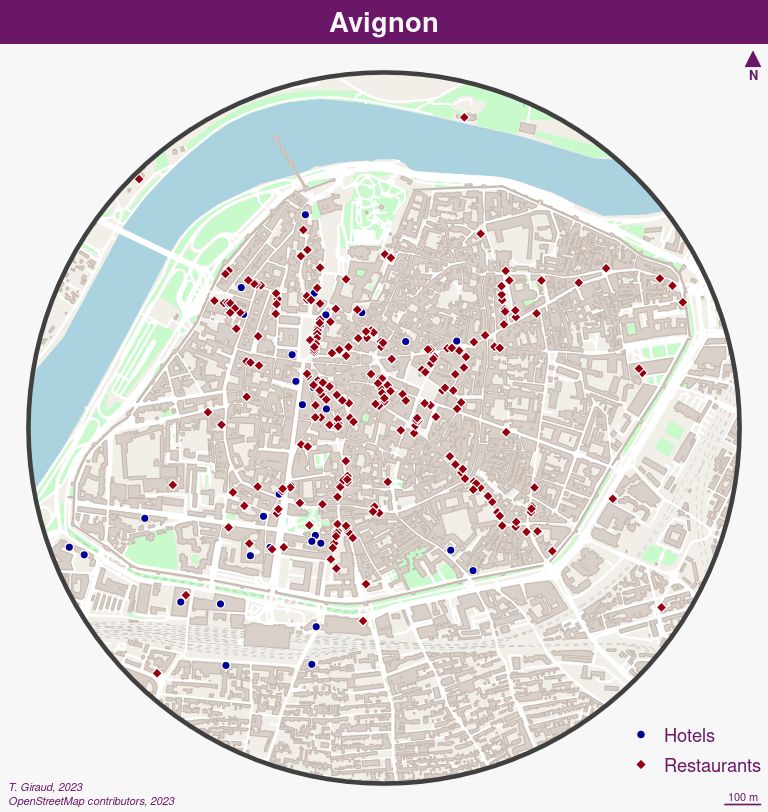
De l’hotel à la conf…
Nous voulons connaître tous les chemins empruntés par les conférenciers pour se rendre au Rencontres R 2023!
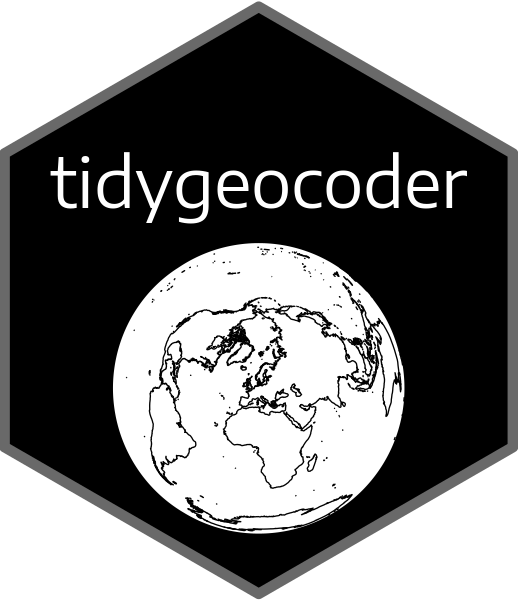
Le package tidygeocoder (Cambon et al., 2021) permet d’utiliser un grand nombre de services de géocodage en ligne.
Passing 1 address to the Nominatim single address geocoderQuery completed in: 1 seconds# A tibble: 1 × 3
address lat long
<chr> <dbl> <dbl>
1 74 rue Louis Pasteur, 84000 Avignon, FRANCE 43.9 4.82Positionnons la conf sur la carte
library(sf)
geoconf <- st_as_sf(conf, coords = c("long", "lat"), crs = "EPSG:4326") |>
st_transform(st_crs(center))
mf_export(center, "img/avignon_conf.png", width = 768, res = 110)
mf_map(center, col = "#f2efe9", border = NA, add = TRUE)
mf_map(river, col = "#aad3df", border = "#aad3df", lwd = .5, add = TRUE)
mf_map(esp_vert, col = "#c8facc", border = "#c8facc", lwd = .5, add = TRUE)
mf_map(rail, col = "grey50", lty = 2, lwd = .2, add = TRUE)
mf_map(routes, col = "white", border = "white", add = TRUE)
mf_map(batiments, col = "#d9d0c9", border = "#c6bab1", lwd = 1, add = TRUE)
mf_map(geoconf, col = "white", bg = "#646400", pch = 22, lwd = 1, cex = 4, add = TRUE)
mf_map(hotel, col = "white", bg = "#000094", pch = 21, lwd = 1, cex = 1, add = TRUE)
mf_map(center, col = NA, border = "grey25", lwd = 4, add = TRUE)
mf_title("Rencontres R 2023")
mf_credits("T. Giraud, 2023\nOpenStreetMap contributors, 2023")
mf_scale(250, unit = "m")
mf_arrow(pos = "topright")
dev.off()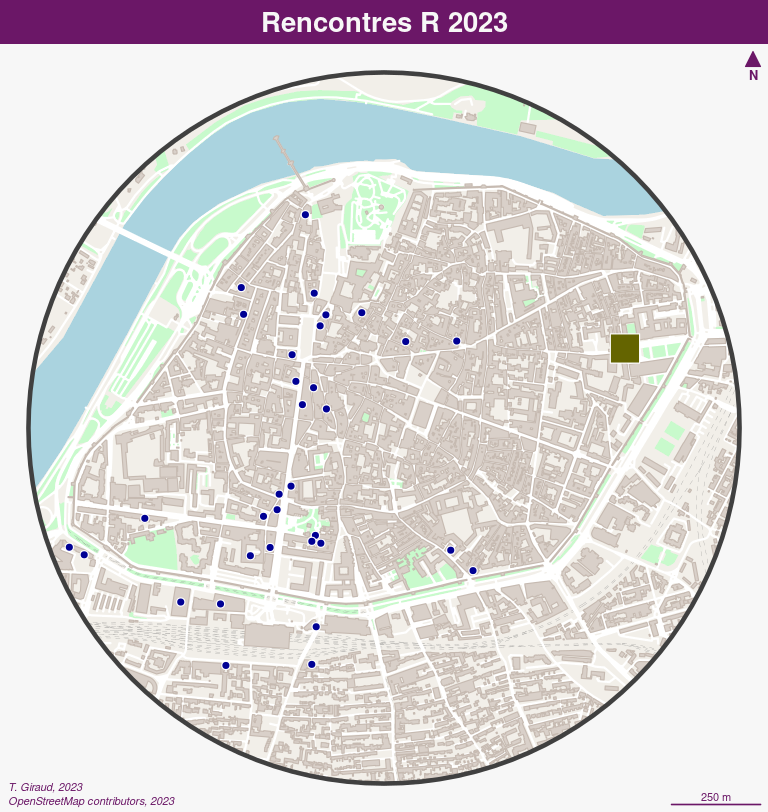
De l’hotel à la conf…
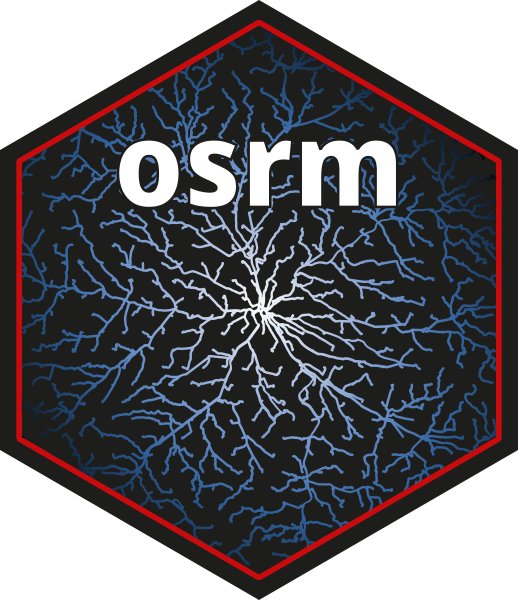
Le package osrm (Giraud, 2022b) permet de calculer des trajets par le plus court chemin en s’appuyant sur les données d’OSM.
Cartographie des routes
mf_export(center, "img/avignon_routes.png", width = 768, res = 110)
mf_map(center, col = "#f2efe9", border = NA, add = TRUE)
mf_map(river, col = "#aad3df", border = "#aad3df", lwd = .5, add = TRUE)
mf_map(esp_vert, col = "#c8facc", border = "#c8facc", lwd = .5, add = TRUE)
mf_map(rail, col = "grey50", lty = 2, lwd = .2, add = TRUE)
mf_map(routes, col = "white", border = "white", add = TRUE)
mf_map(batiments, col = "#d9d0c9", border = "#c6bab1", lwd = 1, add = TRUE)
mf_map(routes_hotel, col = "#940000", lwd = 2, add = TRUE)
mf_map(hotel, col = "white", bg = "#000094", pch = 21, lwd = 1, cex = 1, add = TRUE)
mf_map(geoconf, col = "white", bg = "#646400", pch = 22, lwd = 1, cex = 3, add = TRUE)
mf_map(center, col = NA, border = "grey25", lwd = 4, add = TRUE)
mf_title("Toutes les routes mènent aux Rencontres R")
mf_credits("T. Giraud, 2023\nOpenStreetMap contributors, 2023")
mf_scale(100, unit = "m")
mf_arrow(pos = "topright")
dev.off()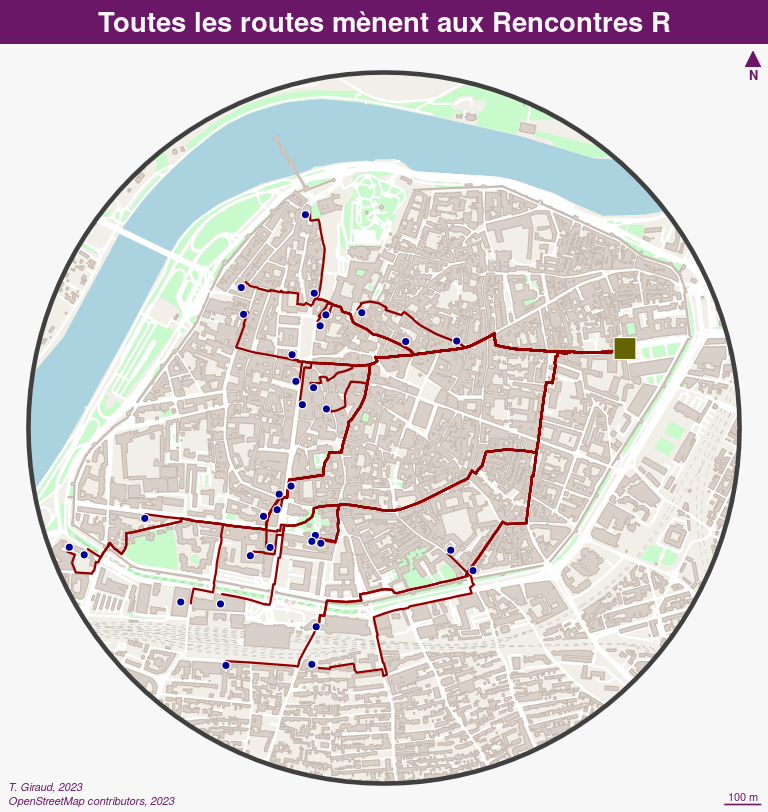
De l’hotel à la conf…
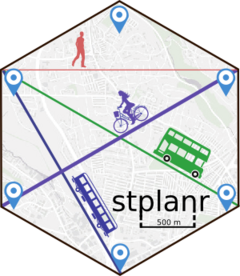
Il est possible d’agréger les tronçons empruntés par plusieurs routes grâce au package stplanr (Lovelace et Ellison, 2018).
Nous pouvons ensuite cartographier ces tronçons agrégés par classes de taille.
Cartographie
mf_export(center, "img/avignon_routes_ag.png", width = 768, res = 110)
mf_map(center, col = "#f2efe9", border = NA, add = TRUE)
mf_map(river, col = "#aad3df", border = "#aad3df", lwd = .5, add = TRUE)
mf_map(esp_vert, col = "#c8facc", border = "#c8facc", lwd = .5, add = TRUE)
mf_map(rail, col = "grey50", lty = 2, lwd = .2, add = TRUE)
mf_map(routes, col = "white", border = "white", add = TRUE)
mf_map(batiments, col = "#d9d0c9", border = "#c6bab1", lwd = 1, add = TRUE)
mf_map(routes_hotel_ag, var = "w", type = "grad",
breaks = c(1,5,10,20,30,33),
lwd = c(2,5,9,13,19),
leg_pos = "topleft", col= "#940000",
leg_title = 'Nombre de trajets\nempruntant la voie',
add = TRUE)
mf_map(hotel, col = "white", bg = "#000094", pch = 21, lwd = 1, cex = 1, add = TRUE)
mf_map(geoconf, col = "white", bg = "#646400", pch = 22, lwd = 1, cex = 3, add = TRUE)
mf_map(center, col = NA, border = "grey25", lwd = 4, add = TRUE)
mf_title("Toutes les routes mènent aux Rencontres R")
mf_credits("T. Giraud, 2023\nOpenStreetMap contributors, 2023")
mf_scale(100, unit = "m")
mf_arrow(pos = "topright")
dev.off()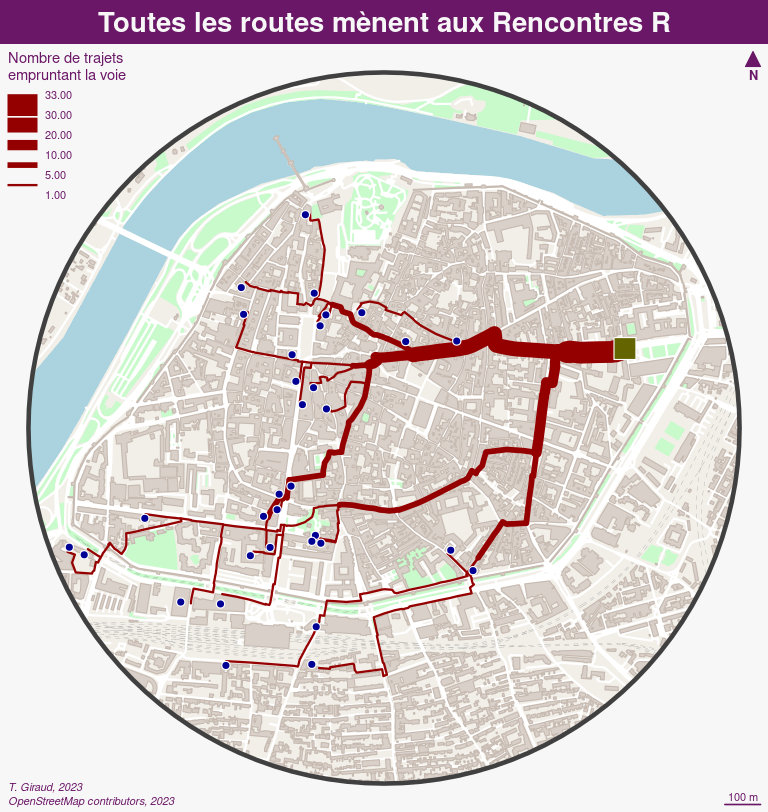
Ressources
Geocomputation with R
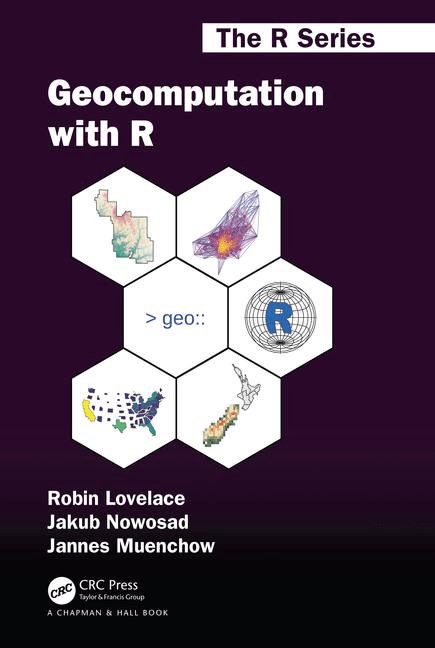
Spatial Data Science with applications in R
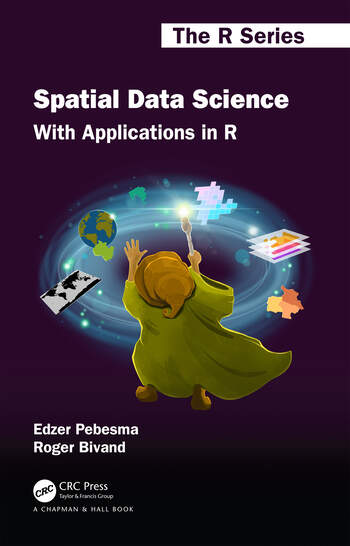
Pebesma et Bivand (2023)
Spatial Data Science with R and “terra”

Robert J. Hijmans (2023)
Cartographie et Géomatique avec R
Rzine

Rzine vise à Encourager la production et favoriser la diffusion de documentation sur la pratique de R en SHS.
- Référencement de documents et supports divers.
- La collection Rzine : publications open source, open peer review.
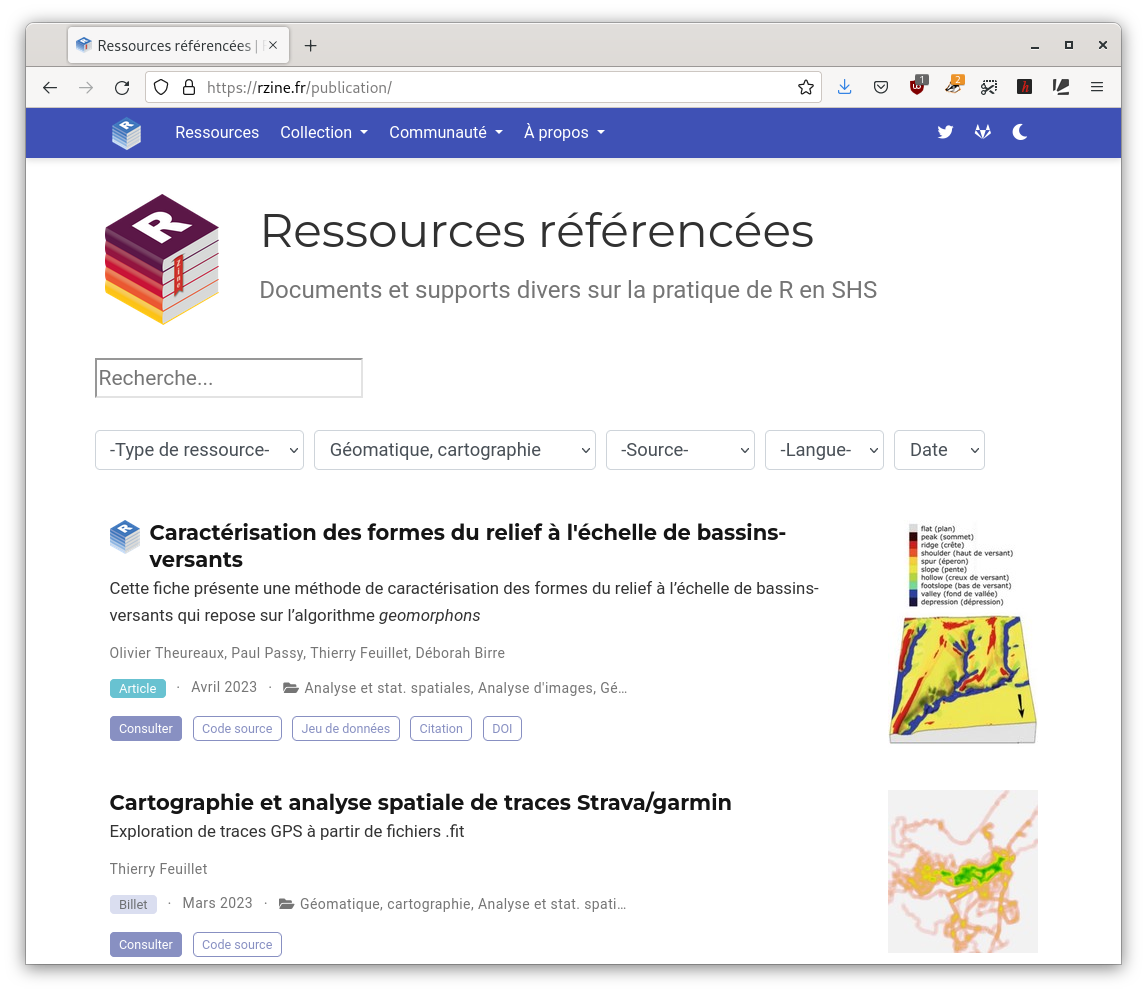
ElementR
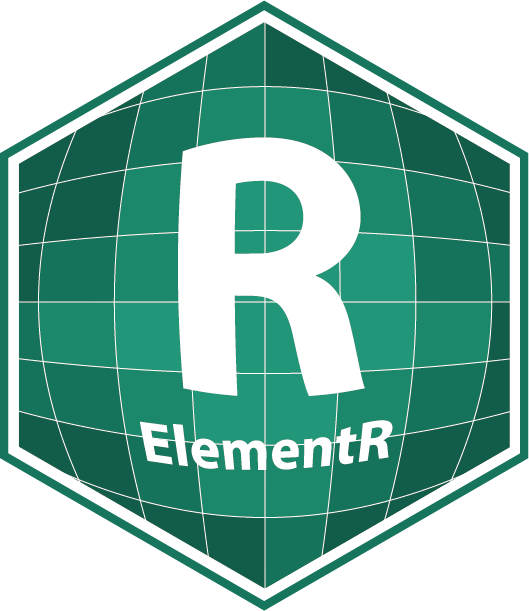
ElementR est un groupe d’autoformation qui fédère trois unités de recherche en géographie : l’UMR Géographie-Cités, l’UMR PRODIG et l’UAR RIATE.
Ses activités sont accessibles à l’ensemble des membres du Campus Condorcet.
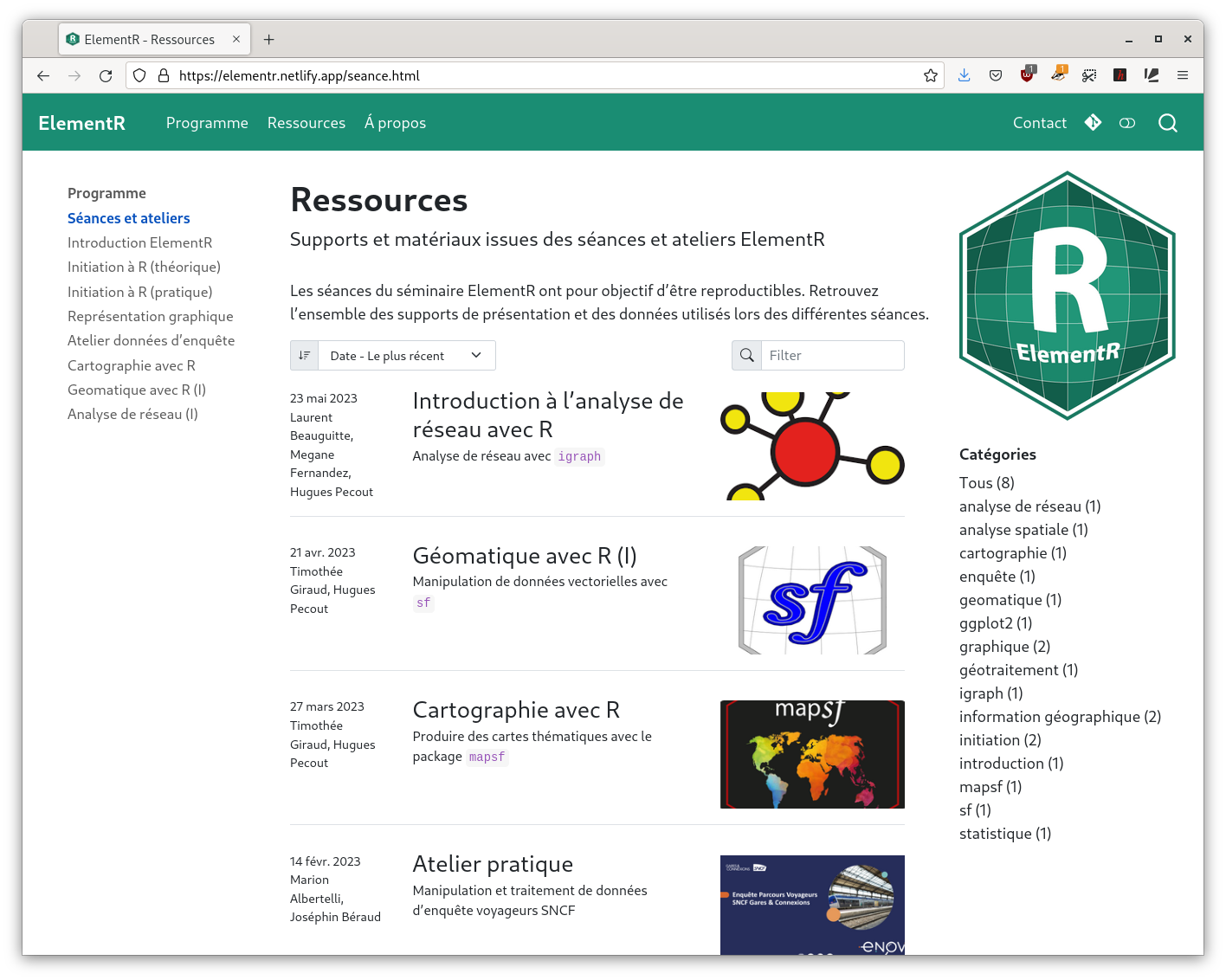
Ressources
Merci de votre attention

Bibliographie
